Student Assessment Manual for BSBWHS501 Ensure a Safe Workplace
VerifiedAdded on 2023/06/11
|22
|5241
|381
AI Summary
This manual provides information for students on how they will be assessed in BSBWHS501 Ensure a Safe Workplace. It covers the assessment process, how to format assessments, and how to reference sources. The manual also includes a practical demonstration checklist for students to complete. The subject is BSBWHS501 and the course code is not mentioned. The college/university is Medicus College.
Contribute Materials
Your contribution can guide someone’s learning journey. Share your
documents today.
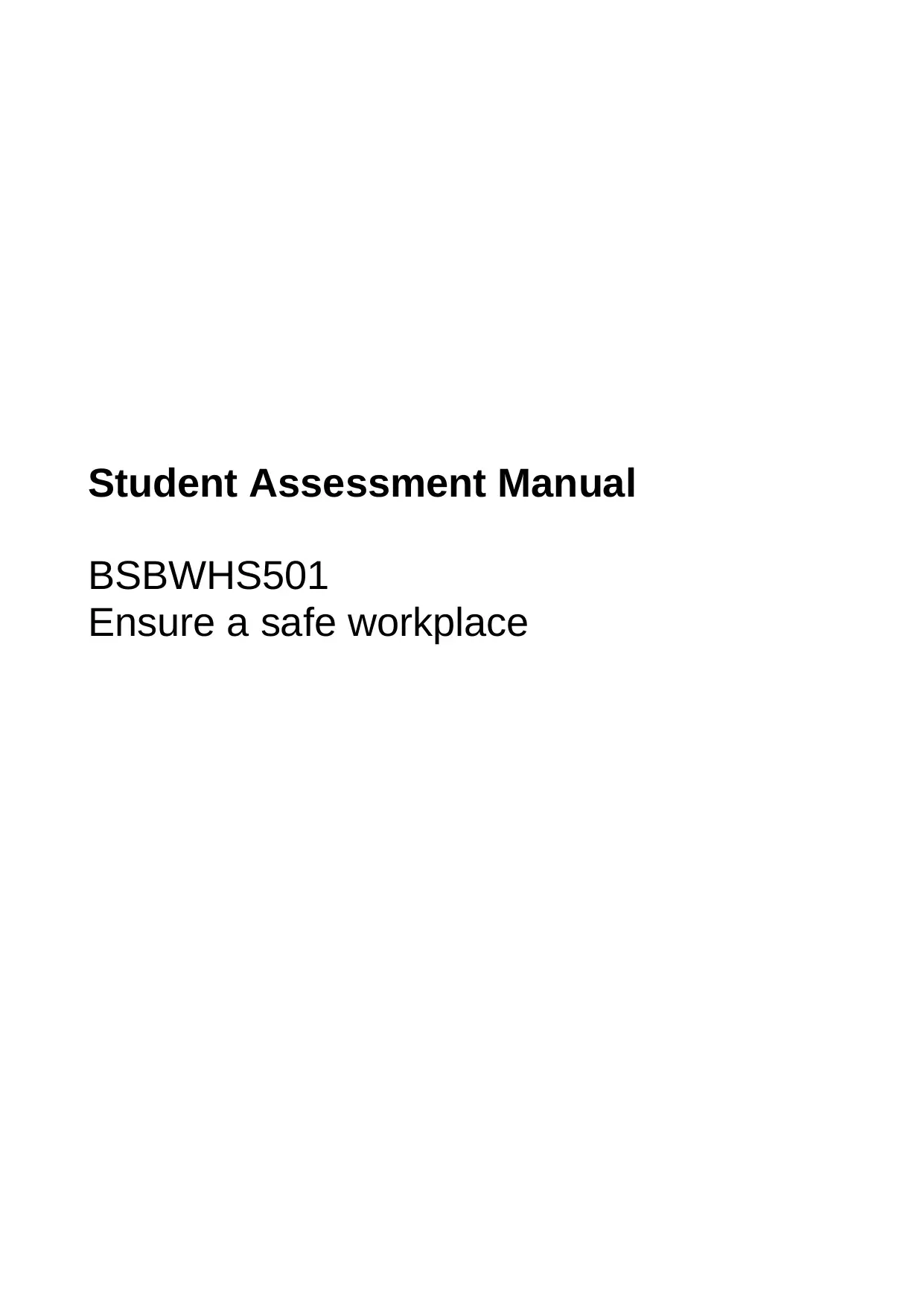
Student Assessment Manual
BSBWHS501
Ensure a safe workplace
BSBWHS501
Ensure a safe workplace
Secure Best Marks with AI Grader
Need help grading? Try our AI Grader for instant feedback on your assignments.
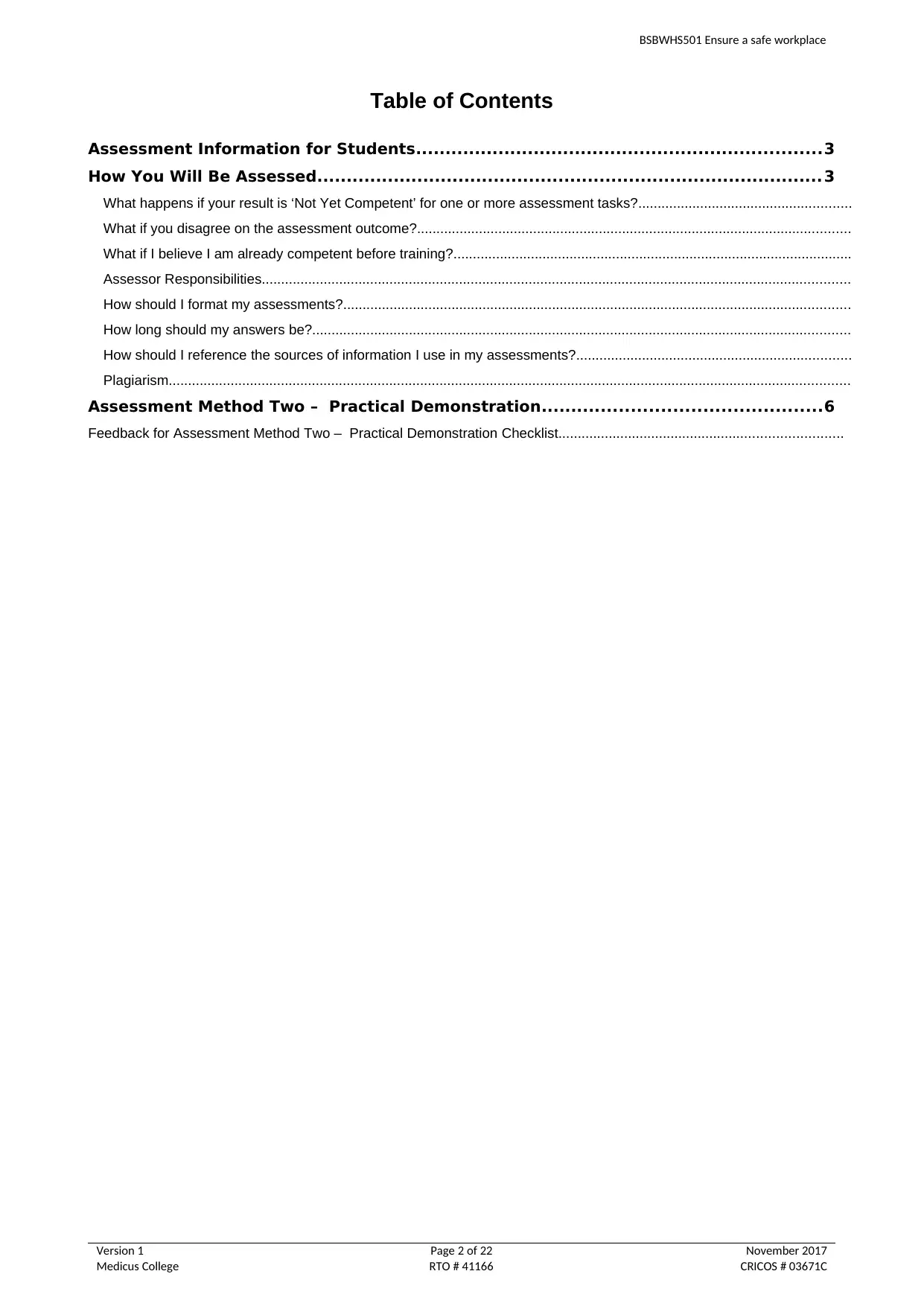
BSBWHS501 Ensure a safe workplace
Table of Contents
Assessment Information for Students.....................................................................3
How You Will Be Assessed......................................................................................3
What happens if your result is ‘Not Yet Competent’ for one or more assessment tasks?.......................................................
What if you disagree on the assessment outcome?................................................................................................................
What if I believe I am already competent before training?.......................................................................................................
Assessor Responsibilities........................................................................................................................................................
How should I format my assessments?...................................................................................................................................
How long should my answers be?...........................................................................................................................................
How should I reference the sources of information I use in my assessments?.......................................................................
Plagiarism................................................................................................................................................................................
Assessment Method Two – Practical Demonstration...............................................6
Feedback for Assessment Method Two – Practical Demonstration Checklist.........................................................................
Version 1 Page 2 of 22 November 2017
Medicus College RTO # 41166 CRICOS # 03671C
Table of Contents
Assessment Information for Students.....................................................................3
How You Will Be Assessed......................................................................................3
What happens if your result is ‘Not Yet Competent’ for one or more assessment tasks?.......................................................
What if you disagree on the assessment outcome?................................................................................................................
What if I believe I am already competent before training?.......................................................................................................
Assessor Responsibilities........................................................................................................................................................
How should I format my assessments?...................................................................................................................................
How long should my answers be?...........................................................................................................................................
How should I reference the sources of information I use in my assessments?.......................................................................
Plagiarism................................................................................................................................................................................
Assessment Method Two – Practical Demonstration...............................................6
Feedback for Assessment Method Two – Practical Demonstration Checklist.........................................................................
Version 1 Page 2 of 22 November 2017
Medicus College RTO # 41166 CRICOS # 03671C
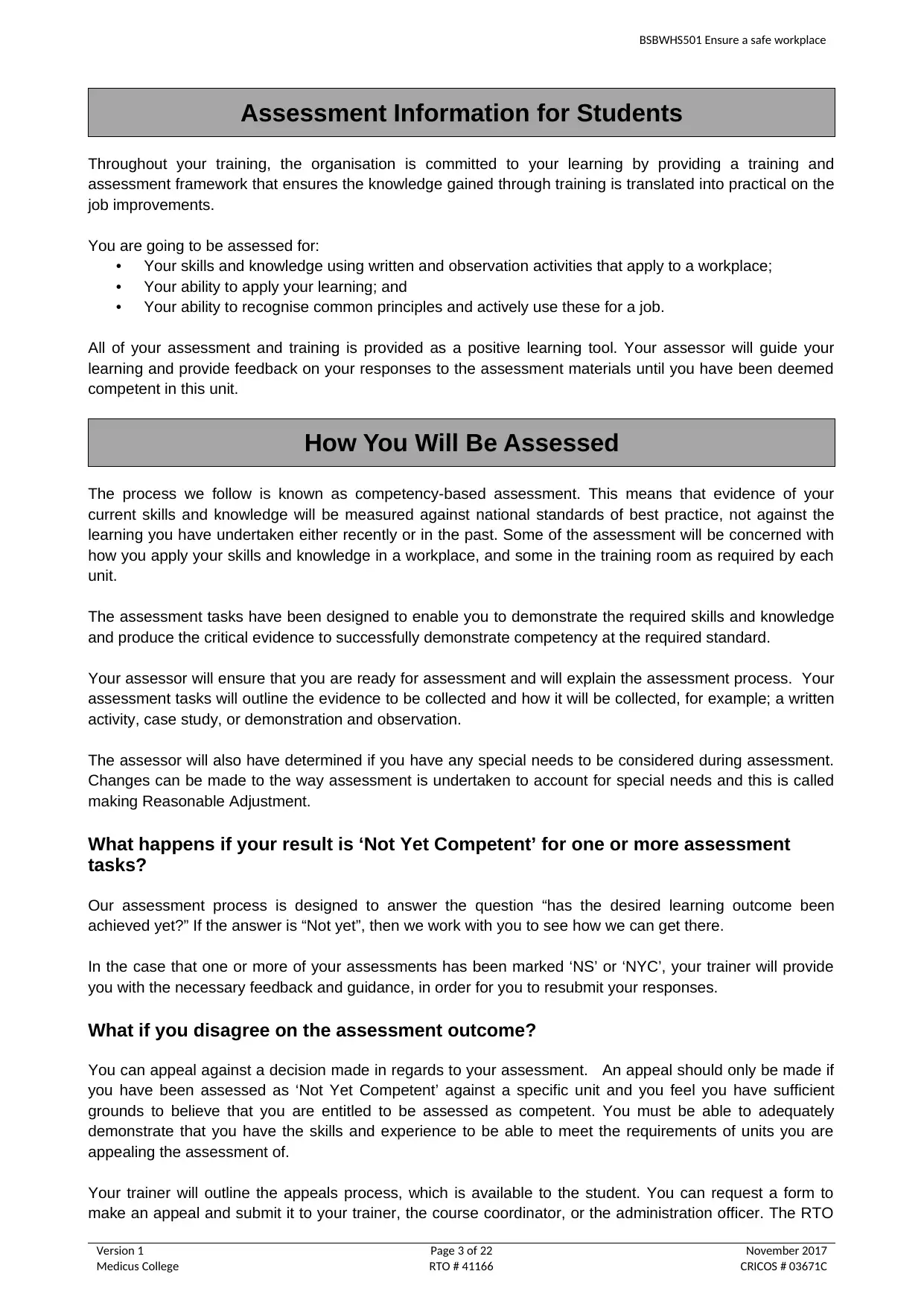
BSBWHS501 Ensure a safe workplace
Assessment Information for Students
Throughout your training, the organisation is committed to your learning by providing a training and
assessment framework that ensures the knowledge gained through training is translated into practical on the
job improvements.
You are going to be assessed for:
• Your skills and knowledge using written and observation activities that apply to a workplace;
• Your ability to apply your learning; and
• Your ability to recognise common principles and actively use these for a job.
All of your assessment and training is provided as a positive learning tool. Your assessor will guide your
learning and provide feedback on your responses to the assessment materials until you have been deemed
competent in this unit.
How You Will Be Assessed
The process we follow is known as competency-based assessment. This means that evidence of your
current skills and knowledge will be measured against national standards of best practice, not against the
learning you have undertaken either recently or in the past. Some of the assessment will be concerned with
how you apply your skills and knowledge in a workplace, and some in the training room as required by each
unit.
The assessment tasks have been designed to enable you to demonstrate the required skills and knowledge
and produce the critical evidence to successfully demonstrate competency at the required standard.
Your assessor will ensure that you are ready for assessment and will explain the assessment process. Your
assessment tasks will outline the evidence to be collected and how it will be collected, for example; a written
activity, case study, or demonstration and observation.
The assessor will also have determined if you have any special needs to be considered during assessment.
Changes can be made to the way assessment is undertaken to account for special needs and this is called
making Reasonable Adjustment.
What happens if your result is ‘Not Yet Competent’ for one or more assessment
tasks?
Our assessment process is designed to answer the question “has the desired learning outcome been
achieved yet?” If the answer is “Not yet”, then we work with you to see how we can get there.
In the case that one or more of your assessments has been marked ‘NS’ or ‘NYC’, your trainer will provide
you with the necessary feedback and guidance, in order for you to resubmit your responses.
What if you disagree on the assessment outcome?
You can appeal against a decision made in regards to your assessment. An appeal should only be made if
you have been assessed as ‘Not Yet Competent’ against a specific unit and you feel you have sufficient
grounds to believe that you are entitled to be assessed as competent. You must be able to adequately
demonstrate that you have the skills and experience to be able to meet the requirements of units you are
appealing the assessment of.
Your trainer will outline the appeals process, which is available to the student. You can request a form to
make an appeal and submit it to your trainer, the course coordinator, or the administration officer. The RTO
Version 1 Page 3 of 22 November 2017
Medicus College RTO # 41166 CRICOS # 03671C
Assessment Information for Students
Throughout your training, the organisation is committed to your learning by providing a training and
assessment framework that ensures the knowledge gained through training is translated into practical on the
job improvements.
You are going to be assessed for:
• Your skills and knowledge using written and observation activities that apply to a workplace;
• Your ability to apply your learning; and
• Your ability to recognise common principles and actively use these for a job.
All of your assessment and training is provided as a positive learning tool. Your assessor will guide your
learning and provide feedback on your responses to the assessment materials until you have been deemed
competent in this unit.
How You Will Be Assessed
The process we follow is known as competency-based assessment. This means that evidence of your
current skills and knowledge will be measured against national standards of best practice, not against the
learning you have undertaken either recently or in the past. Some of the assessment will be concerned with
how you apply your skills and knowledge in a workplace, and some in the training room as required by each
unit.
The assessment tasks have been designed to enable you to demonstrate the required skills and knowledge
and produce the critical evidence to successfully demonstrate competency at the required standard.
Your assessor will ensure that you are ready for assessment and will explain the assessment process. Your
assessment tasks will outline the evidence to be collected and how it will be collected, for example; a written
activity, case study, or demonstration and observation.
The assessor will also have determined if you have any special needs to be considered during assessment.
Changes can be made to the way assessment is undertaken to account for special needs and this is called
making Reasonable Adjustment.
What happens if your result is ‘Not Yet Competent’ for one or more assessment
tasks?
Our assessment process is designed to answer the question “has the desired learning outcome been
achieved yet?” If the answer is “Not yet”, then we work with you to see how we can get there.
In the case that one or more of your assessments has been marked ‘NS’ or ‘NYC’, your trainer will provide
you with the necessary feedback and guidance, in order for you to resubmit your responses.
What if you disagree on the assessment outcome?
You can appeal against a decision made in regards to your assessment. An appeal should only be made if
you have been assessed as ‘Not Yet Competent’ against a specific unit and you feel you have sufficient
grounds to believe that you are entitled to be assessed as competent. You must be able to adequately
demonstrate that you have the skills and experience to be able to meet the requirements of units you are
appealing the assessment of.
Your trainer will outline the appeals process, which is available to the student. You can request a form to
make an appeal and submit it to your trainer, the course coordinator, or the administration officer. The RTO
Version 1 Page 3 of 22 November 2017
Medicus College RTO # 41166 CRICOS # 03671C
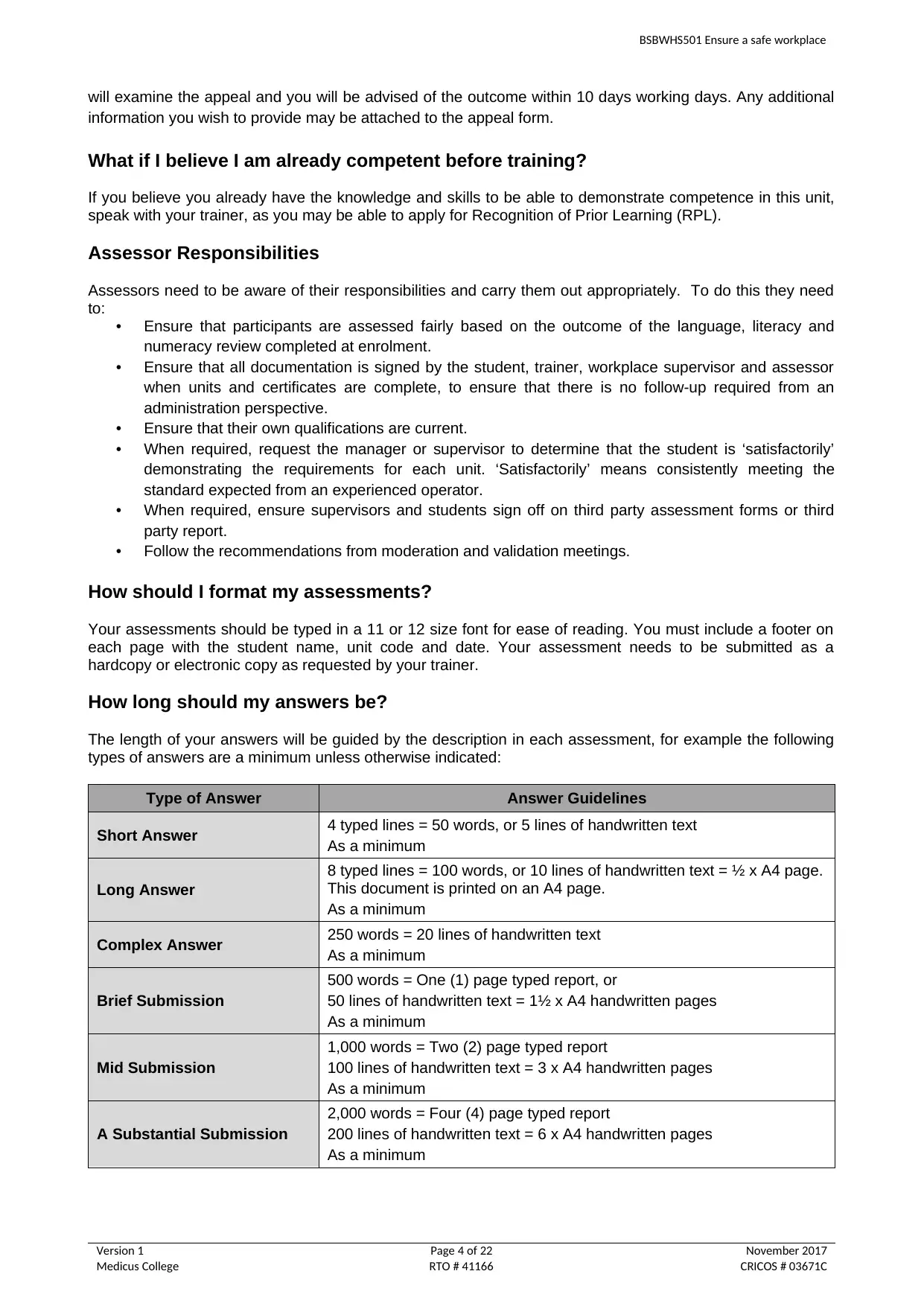
BSBWHS501 Ensure a safe workplace
will examine the appeal and you will be advised of the outcome within 10 days working days. Any additional
information you wish to provide may be attached to the appeal form.
What if I believe I am already competent before training?
If you believe you already have the knowledge and skills to be able to demonstrate competence in this unit,
speak with your trainer, as you may be able to apply for Recognition of Prior Learning (RPL).
Assessor Responsibilities
Assessors need to be aware of their responsibilities and carry them out appropriately. To do this they need
to:
• Ensure that participants are assessed fairly based on the outcome of the language, literacy and
numeracy review completed at enrolment.
• Ensure that all documentation is signed by the student, trainer, workplace supervisor and assessor
when units and certificates are complete, to ensure that there is no follow-up required from an
administration perspective.
• Ensure that their own qualifications are current.
• When required, request the manager or supervisor to determine that the student is ‘satisfactorily’
demonstrating the requirements for each unit. ‘Satisfactorily’ means consistently meeting the
standard expected from an experienced operator.
• When required, ensure supervisors and students sign off on third party assessment forms or third
party report.
• Follow the recommendations from moderation and validation meetings.
How should I format my assessments?
Your assessments should be typed in a 11 or 12 size font for ease of reading. You must include a footer on
each page with the student name, unit code and date. Your assessment needs to be submitted as a
hardcopy or electronic copy as requested by your trainer.
How long should my answers be?
The length of your answers will be guided by the description in each assessment, for example the following
types of answers are a minimum unless otherwise indicated:
Type of Answer Answer Guidelines
Short Answer 4 typed lines = 50 words, or 5 lines of handwritten text
As a minimum
Long Answer
8 typed lines = 100 words, or 10 lines of handwritten text = ½ x A4 page.
This document is printed on an A4 page.
As a minimum
Complex Answer 250 words = 20 lines of handwritten text
As a minimum
Brief Submission
500 words = One (1) page typed report, or
50 lines of handwritten text = 1½ x A4 handwritten pages
As a minimum
Mid Submission
1,000 words = Two (2) page typed report
100 lines of handwritten text = 3 x A4 handwritten pages
As a minimum
A Substantial Submission
2,000 words = Four (4) page typed report
200 lines of handwritten text = 6 x A4 handwritten pages
As a minimum
Version 1 Page 4 of 22 November 2017
Medicus College RTO # 41166 CRICOS # 03671C
will examine the appeal and you will be advised of the outcome within 10 days working days. Any additional
information you wish to provide may be attached to the appeal form.
What if I believe I am already competent before training?
If you believe you already have the knowledge and skills to be able to demonstrate competence in this unit,
speak with your trainer, as you may be able to apply for Recognition of Prior Learning (RPL).
Assessor Responsibilities
Assessors need to be aware of their responsibilities and carry them out appropriately. To do this they need
to:
• Ensure that participants are assessed fairly based on the outcome of the language, literacy and
numeracy review completed at enrolment.
• Ensure that all documentation is signed by the student, trainer, workplace supervisor and assessor
when units and certificates are complete, to ensure that there is no follow-up required from an
administration perspective.
• Ensure that their own qualifications are current.
• When required, request the manager or supervisor to determine that the student is ‘satisfactorily’
demonstrating the requirements for each unit. ‘Satisfactorily’ means consistently meeting the
standard expected from an experienced operator.
• When required, ensure supervisors and students sign off on third party assessment forms or third
party report.
• Follow the recommendations from moderation and validation meetings.
How should I format my assessments?
Your assessments should be typed in a 11 or 12 size font for ease of reading. You must include a footer on
each page with the student name, unit code and date. Your assessment needs to be submitted as a
hardcopy or electronic copy as requested by your trainer.
How long should my answers be?
The length of your answers will be guided by the description in each assessment, for example the following
types of answers are a minimum unless otherwise indicated:
Type of Answer Answer Guidelines
Short Answer 4 typed lines = 50 words, or 5 lines of handwritten text
As a minimum
Long Answer
8 typed lines = 100 words, or 10 lines of handwritten text = ½ x A4 page.
This document is printed on an A4 page.
As a minimum
Complex Answer 250 words = 20 lines of handwritten text
As a minimum
Brief Submission
500 words = One (1) page typed report, or
50 lines of handwritten text = 1½ x A4 handwritten pages
As a minimum
Mid Submission
1,000 words = Two (2) page typed report
100 lines of handwritten text = 3 x A4 handwritten pages
As a minimum
A Substantial Submission
2,000 words = Four (4) page typed report
200 lines of handwritten text = 6 x A4 handwritten pages
As a minimum
Version 1 Page 4 of 22 November 2017
Medicus College RTO # 41166 CRICOS # 03671C
Secure Best Marks with AI Grader
Need help grading? Try our AI Grader for instant feedback on your assignments.
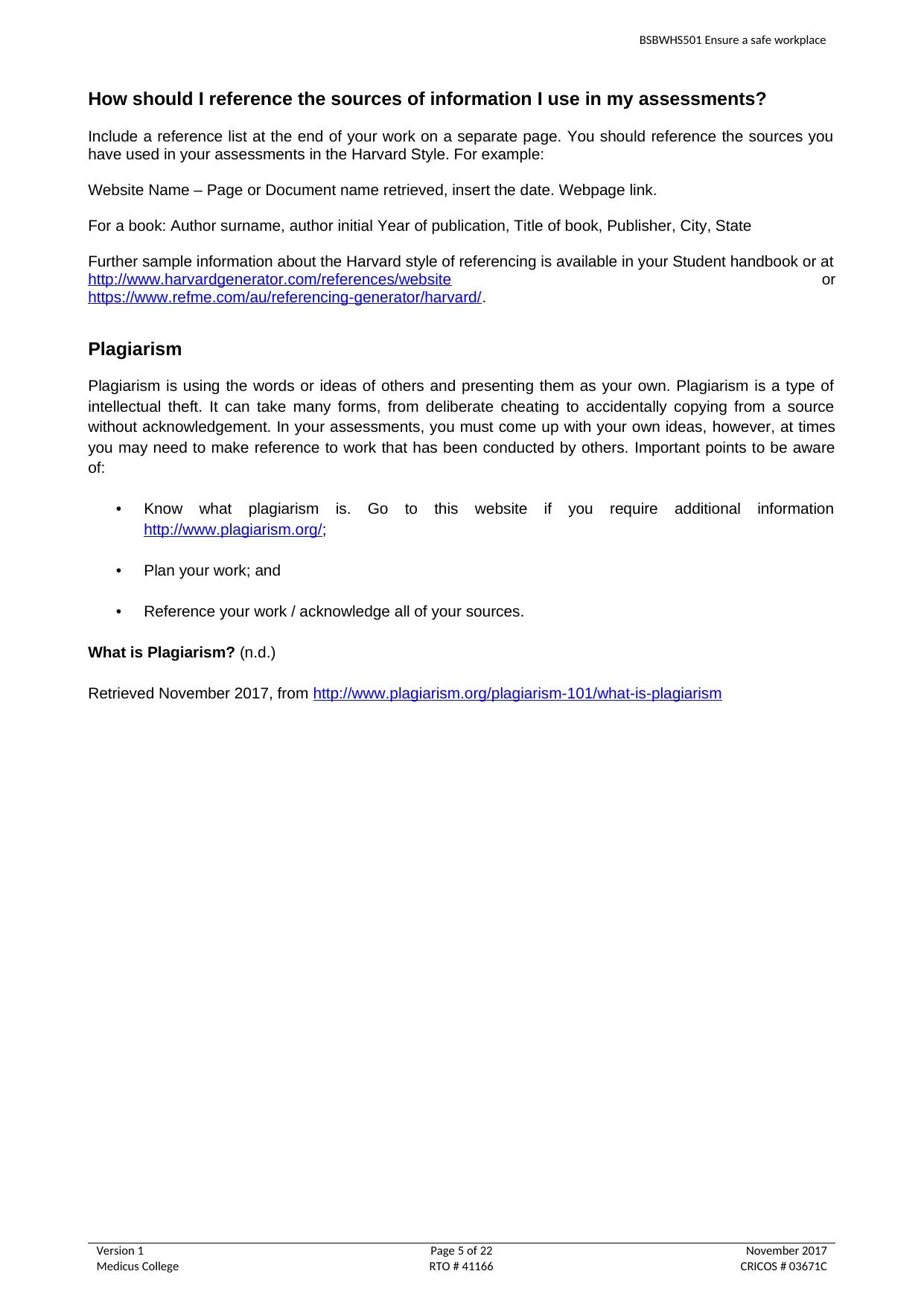
BSBWHS501 Ensure a safe workplace
How should I reference the sources of information I use in my assessments?
Include a reference list at the end of your work on a separate page. You should reference the sources you
have used in your assessments in the Harvard Style. For example:
Website Name – Page or Document name retrieved, insert the date. Webpage link.
For a book: Author surname, author initial Year of publication, Title of book, Publisher, City, State
Further sample information about the Harvard style of referencing is available in your Student handbook or at
http://www.harvardgenerator.com/references/website or
https://www.refme.com/au/referencing-generator/harvard/.
Plagiarism
Plagiarism is using the words or ideas of others and presenting them as your own. Plagiarism is a type of
intellectual theft. It can take many forms, from deliberate cheating to accidentally copying from a source
without acknowledgement. In your assessments, you must come up with your own ideas, however, at times
you may need to make reference to work that has been conducted by others. Important points to be aware
of:
• Know what plagiarism is. Go to this website if you require additional information
http://www.plagiarism.org/;
• Plan your work; and
• Reference your work / acknowledge all of your sources.
What is Plagiarism? (n.d.)
Retrieved November 2017, from http://www.plagiarism.org/plagiarism-101/what-is-plagiarism
Version 1 Page 5 of 22 November 2017
Medicus College RTO # 41166 CRICOS # 03671C
How should I reference the sources of information I use in my assessments?
Include a reference list at the end of your work on a separate page. You should reference the sources you
have used in your assessments in the Harvard Style. For example:
Website Name – Page or Document name retrieved, insert the date. Webpage link.
For a book: Author surname, author initial Year of publication, Title of book, Publisher, City, State
Further sample information about the Harvard style of referencing is available in your Student handbook or at
http://www.harvardgenerator.com/references/website or
https://www.refme.com/au/referencing-generator/harvard/.
Plagiarism
Plagiarism is using the words or ideas of others and presenting them as your own. Plagiarism is a type of
intellectual theft. It can take many forms, from deliberate cheating to accidentally copying from a source
without acknowledgement. In your assessments, you must come up with your own ideas, however, at times
you may need to make reference to work that has been conducted by others. Important points to be aware
of:
• Know what plagiarism is. Go to this website if you require additional information
http://www.plagiarism.org/;
• Plan your work; and
• Reference your work / acknowledge all of your sources.
What is Plagiarism? (n.d.)
Retrieved November 2017, from http://www.plagiarism.org/plagiarism-101/what-is-plagiarism
Version 1 Page 5 of 22 November 2017
Medicus College RTO # 41166 CRICOS # 03671C
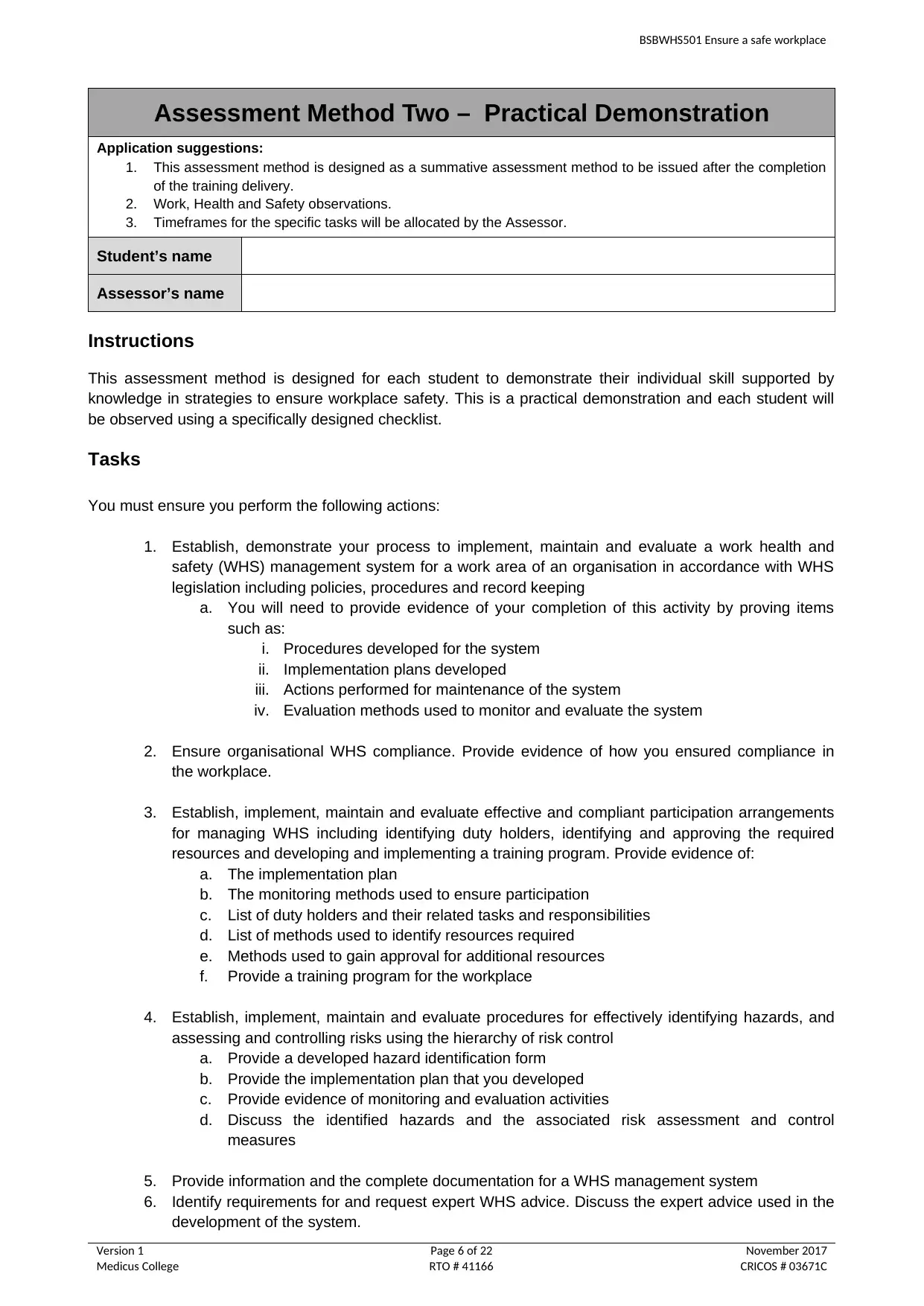
BSBWHS501 Ensure a safe workplace
Assessment Method Two – Practical Demonstration
Application suggestions:
1. This assessment method is designed as a summative assessment method to be issued after the completion
of the training delivery.
2. Work, Health and Safety observations.
3. Timeframes for the specific tasks will be allocated by the Assessor.
Student’s name
Assessor’s name
Instructions
This assessment method is designed for each student to demonstrate their individual skill supported by
knowledge in strategies to ensure workplace safety. This is a practical demonstration and each student will
be observed using a specifically designed checklist.
Tasks
You must ensure you perform the following actions:
1. Establish, demonstrate your process to implement, maintain and evaluate a work health and
safety (WHS) management system for a work area of an organisation in accordance with WHS
legislation including policies, procedures and record keeping
a. You will need to provide evidence of your completion of this activity by proving items
such as:
i. Procedures developed for the system
ii. Implementation plans developed
iii. Actions performed for maintenance of the system
iv. Evaluation methods used to monitor and evaluate the system
2. Ensure organisational WHS compliance. Provide evidence of how you ensured compliance in
the workplace.
3. Establish, implement, maintain and evaluate effective and compliant participation arrangements
for managing WHS including identifying duty holders, identifying and approving the required
resources and developing and implementing a training program. Provide evidence of:
a. The implementation plan
b. The monitoring methods used to ensure participation
c. List of duty holders and their related tasks and responsibilities
d. List of methods used to identify resources required
e. Methods used to gain approval for additional resources
f. Provide a training program for the workplace
4. Establish, implement, maintain and evaluate procedures for effectively identifying hazards, and
assessing and controlling risks using the hierarchy of risk control
a. Provide a developed hazard identification form
b. Provide the implementation plan that you developed
c. Provide evidence of monitoring and evaluation activities
d. Discuss the identified hazards and the associated risk assessment and control
measures
5. Provide information and the complete documentation for a WHS management system
6. Identify requirements for and request expert WHS advice. Discuss the expert advice used in the
development of the system.
Version 1 Page 6 of 22 November 2017
Medicus College RTO # 41166 CRICOS # 03671C
Assessment Method Two – Practical Demonstration
Application suggestions:
1. This assessment method is designed as a summative assessment method to be issued after the completion
of the training delivery.
2. Work, Health and Safety observations.
3. Timeframes for the specific tasks will be allocated by the Assessor.
Student’s name
Assessor’s name
Instructions
This assessment method is designed for each student to demonstrate their individual skill supported by
knowledge in strategies to ensure workplace safety. This is a practical demonstration and each student will
be observed using a specifically designed checklist.
Tasks
You must ensure you perform the following actions:
1. Establish, demonstrate your process to implement, maintain and evaluate a work health and
safety (WHS) management system for a work area of an organisation in accordance with WHS
legislation including policies, procedures and record keeping
a. You will need to provide evidence of your completion of this activity by proving items
such as:
i. Procedures developed for the system
ii. Implementation plans developed
iii. Actions performed for maintenance of the system
iv. Evaluation methods used to monitor and evaluate the system
2. Ensure organisational WHS compliance. Provide evidence of how you ensured compliance in
the workplace.
3. Establish, implement, maintain and evaluate effective and compliant participation arrangements
for managing WHS including identifying duty holders, identifying and approving the required
resources and developing and implementing a training program. Provide evidence of:
a. The implementation plan
b. The monitoring methods used to ensure participation
c. List of duty holders and their related tasks and responsibilities
d. List of methods used to identify resources required
e. Methods used to gain approval for additional resources
f. Provide a training program for the workplace
4. Establish, implement, maintain and evaluate procedures for effectively identifying hazards, and
assessing and controlling risks using the hierarchy of risk control
a. Provide a developed hazard identification form
b. Provide the implementation plan that you developed
c. Provide evidence of monitoring and evaluation activities
d. Discuss the identified hazards and the associated risk assessment and control
measures
5. Provide information and the complete documentation for a WHS management system
6. Identify requirements for and request expert WHS advice. Discuss the expert advice used in the
development of the system.
Version 1 Page 6 of 22 November 2017
Medicus College RTO # 41166 CRICOS # 03671C
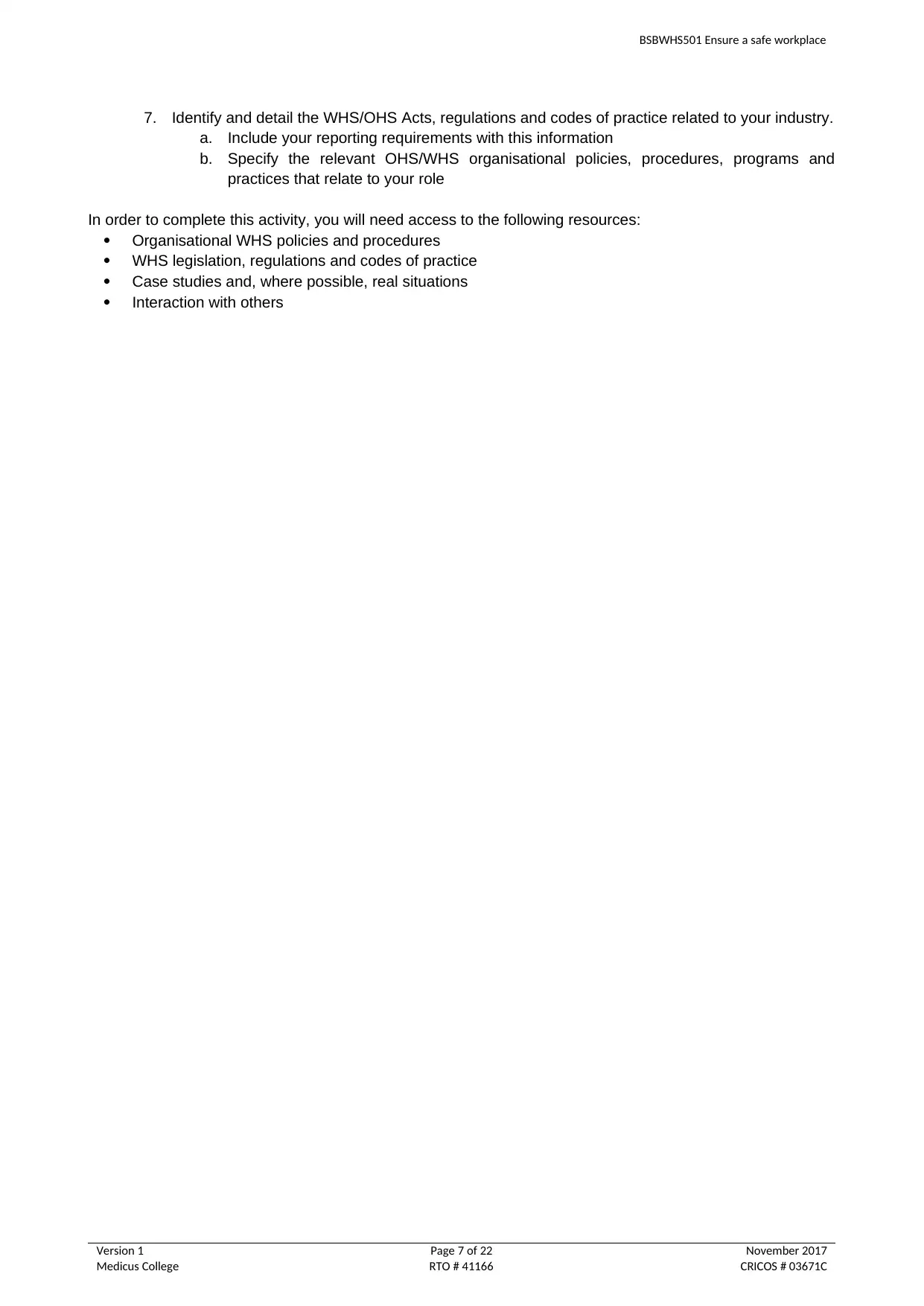
BSBWHS501 Ensure a safe workplace
7. Identify and detail the WHS/OHS Acts, regulations and codes of practice related to your industry.
a. Include your reporting requirements with this information
b. Specify the relevant OHS/WHS organisational policies, procedures, programs and
practices that relate to your role
In order to complete this activity, you will need access to the following resources:
Organisational WHS policies and procedures
WHS legislation, regulations and codes of practice
Case studies and, where possible, real situations
Interaction with others
Version 1 Page 7 of 22 November 2017
Medicus College RTO # 41166 CRICOS # 03671C
7. Identify and detail the WHS/OHS Acts, regulations and codes of practice related to your industry.
a. Include your reporting requirements with this information
b. Specify the relevant OHS/WHS organisational policies, procedures, programs and
practices that relate to your role
In order to complete this activity, you will need access to the following resources:
Organisational WHS policies and procedures
WHS legislation, regulations and codes of practice
Case studies and, where possible, real situations
Interaction with others
Version 1 Page 7 of 22 November 2017
Medicus College RTO # 41166 CRICOS # 03671C
Paraphrase This Document
Need a fresh take? Get an instant paraphrase of this document with our AI Paraphraser
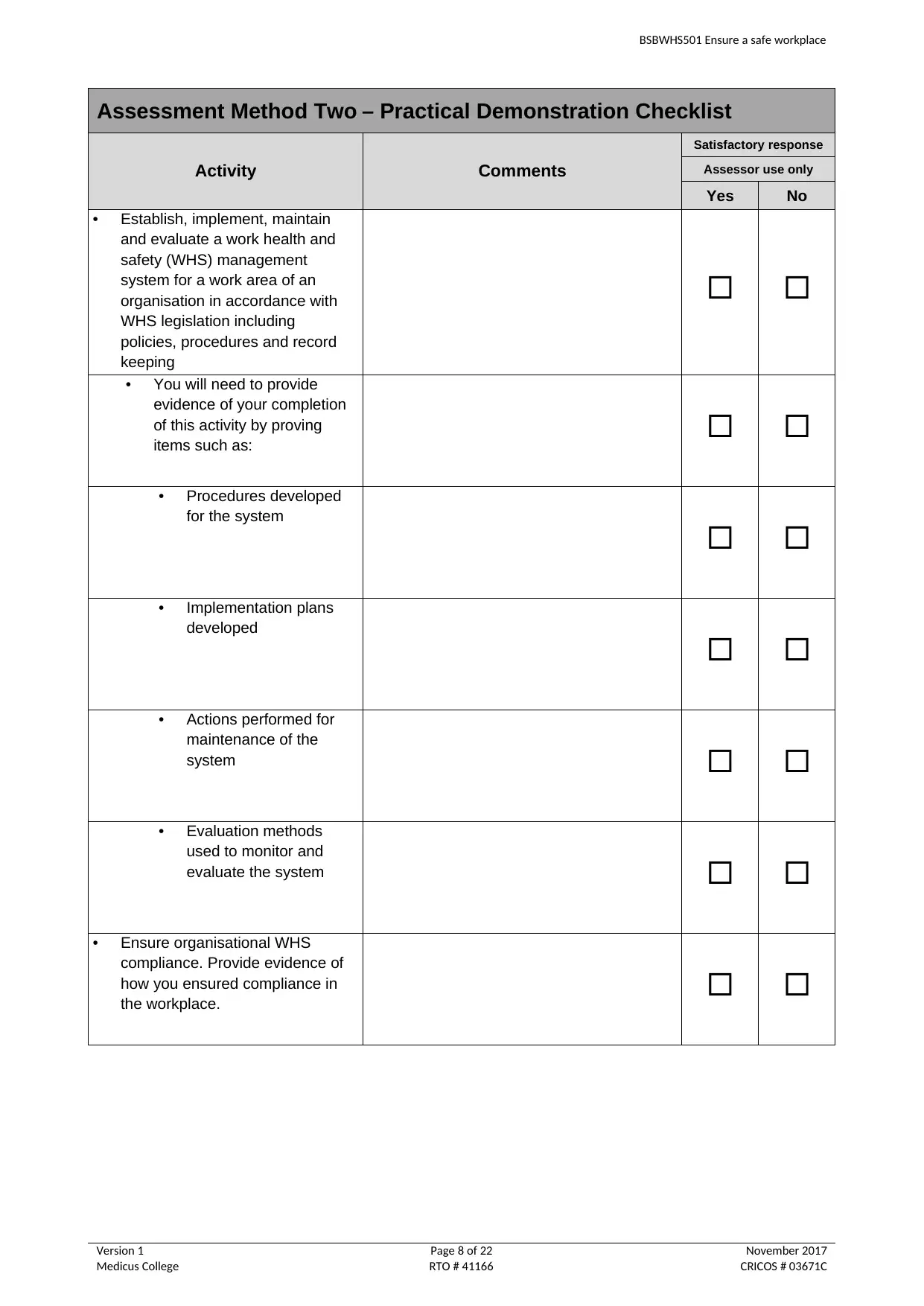
BSBWHS501 Ensure a safe workplace
Assessment Method Two – Practical Demonstration Checklist
Activity Comments
Satisfactory response
Assessor use only
Yes No
• Establish, implement, maintain
and evaluate a work health and
safety (WHS) management
system for a work area of an
organisation in accordance with
WHS legislation including
policies, procedures and record
keeping
• You will need to provide
evidence of your completion
of this activity by proving
items such as:
• Procedures developed
for the system
• Implementation plans
developed
• Actions performed for
maintenance of the
system
• Evaluation methods
used to monitor and
evaluate the system
• Ensure organisational WHS
compliance. Provide evidence of
how you ensured compliance in
the workplace.
Version 1 Page 8 of 22 November 2017
Medicus College RTO # 41166 CRICOS # 03671C
Assessment Method Two – Practical Demonstration Checklist
Activity Comments
Satisfactory response
Assessor use only
Yes No
• Establish, implement, maintain
and evaluate a work health and
safety (WHS) management
system for a work area of an
organisation in accordance with
WHS legislation including
policies, procedures and record
keeping
• You will need to provide
evidence of your completion
of this activity by proving
items such as:
• Procedures developed
for the system
• Implementation plans
developed
• Actions performed for
maintenance of the
system
• Evaluation methods
used to monitor and
evaluate the system
• Ensure organisational WHS
compliance. Provide evidence of
how you ensured compliance in
the workplace.
Version 1 Page 8 of 22 November 2017
Medicus College RTO # 41166 CRICOS # 03671C
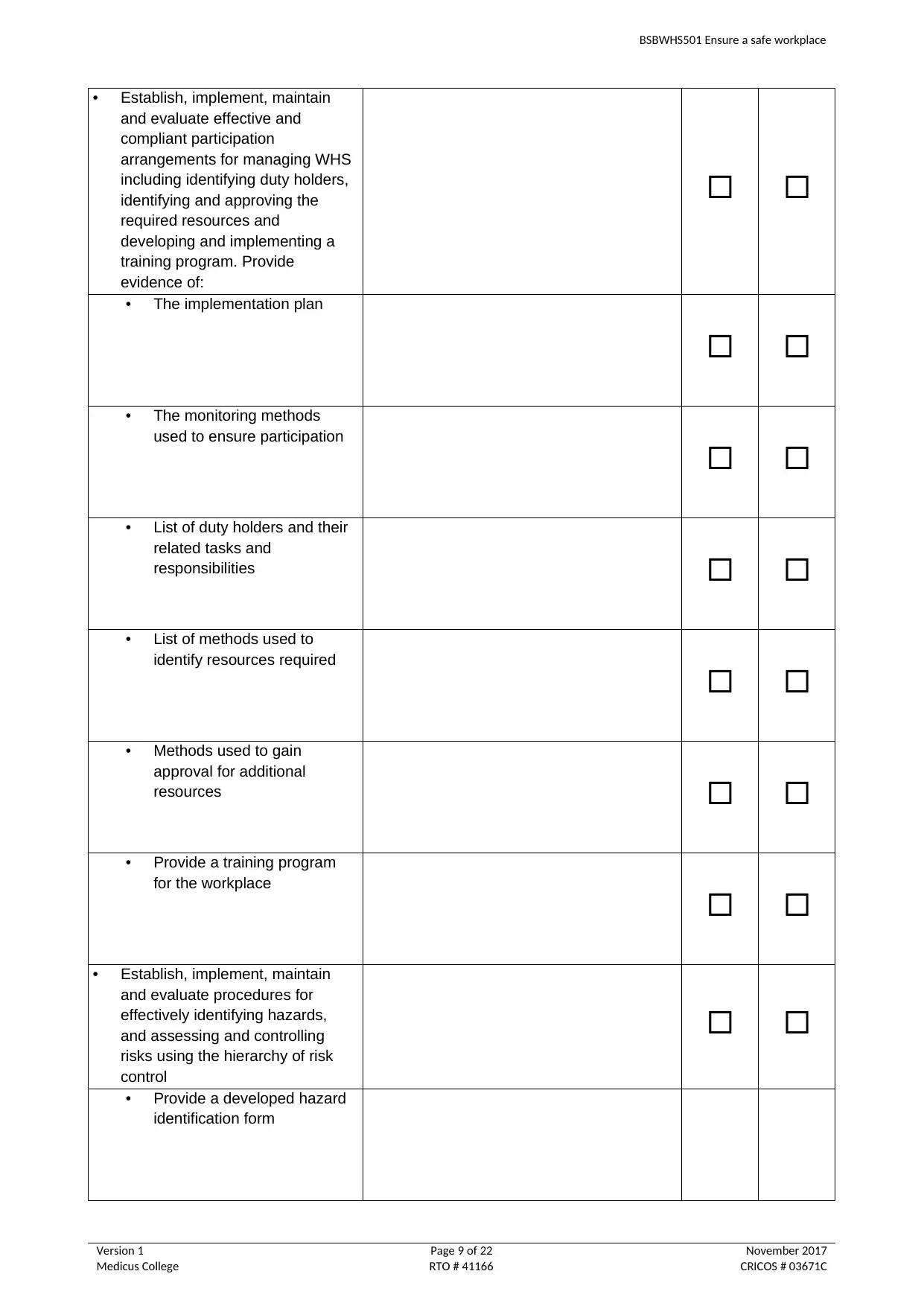
BSBWHS501 Ensure a safe workplace
• Establish, implement, maintain
and evaluate effective and
compliant participation
arrangements for managing WHS
including identifying duty holders,
identifying and approving the
required resources and
developing and implementing a
training program. Provide
evidence of:
• The implementation plan
• The monitoring methods
used to ensure participation
• List of duty holders and their
related tasks and
responsibilities
• List of methods used to
identify resources required
• Methods used to gain
approval for additional
resources
• Provide a training program
for the workplace
• Establish, implement, maintain
and evaluate procedures for
effectively identifying hazards,
and assessing and controlling
risks using the hierarchy of risk
control
• Provide a developed hazard
identification form
Version 1 Page 9 of 22 November 2017
Medicus College RTO # 41166 CRICOS # 03671C
• Establish, implement, maintain
and evaluate effective and
compliant participation
arrangements for managing WHS
including identifying duty holders,
identifying and approving the
required resources and
developing and implementing a
training program. Provide
evidence of:
• The implementation plan
• The monitoring methods
used to ensure participation
• List of duty holders and their
related tasks and
responsibilities
• List of methods used to
identify resources required
• Methods used to gain
approval for additional
resources
• Provide a training program
for the workplace
• Establish, implement, maintain
and evaluate procedures for
effectively identifying hazards,
and assessing and controlling
risks using the hierarchy of risk
control
• Provide a developed hazard
identification form
Version 1 Page 9 of 22 November 2017
Medicus College RTO # 41166 CRICOS # 03671C
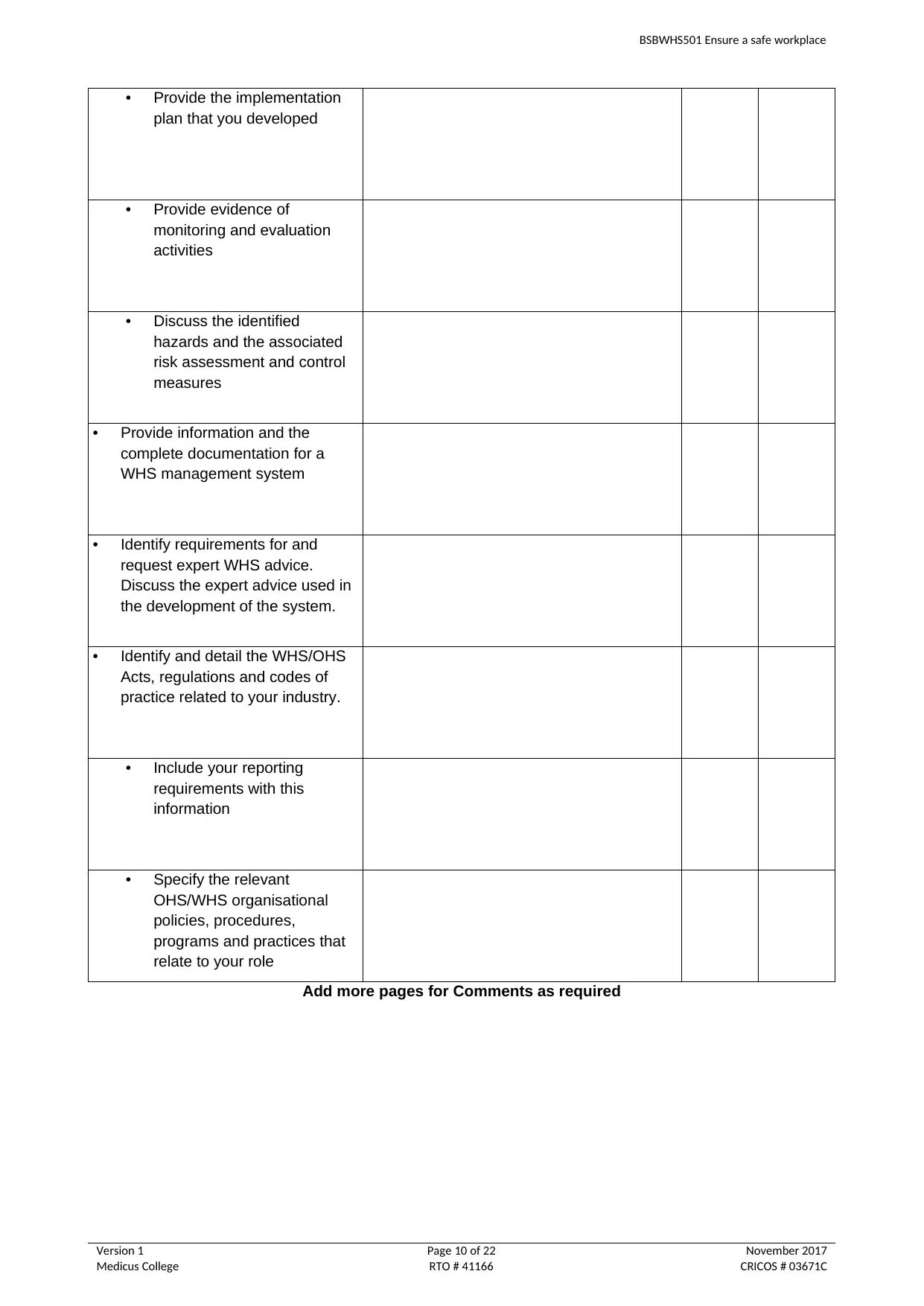
BSBWHS501 Ensure a safe workplace
• Provide the implementation
plan that you developed
• Provide evidence of
monitoring and evaluation
activities
• Discuss the identified
hazards and the associated
risk assessment and control
measures
• Provide information and the
complete documentation for a
WHS management system
• Identify requirements for and
request expert WHS advice.
Discuss the expert advice used in
the development of the system.
• Identify and detail the WHS/OHS
Acts, regulations and codes of
practice related to your industry.
• Include your reporting
requirements with this
information
• Specify the relevant
OHS/WHS organisational
policies, procedures,
programs and practices that
relate to your role
Add more pages for Comments as required
Version 1 Page 10 of 22 November 2017
Medicus College RTO # 41166 CRICOS # 03671C
• Provide the implementation
plan that you developed
• Provide evidence of
monitoring and evaluation
activities
• Discuss the identified
hazards and the associated
risk assessment and control
measures
• Provide information and the
complete documentation for a
WHS management system
• Identify requirements for and
request expert WHS advice.
Discuss the expert advice used in
the development of the system.
• Identify and detail the WHS/OHS
Acts, regulations and codes of
practice related to your industry.
• Include your reporting
requirements with this
information
• Specify the relevant
OHS/WHS organisational
policies, procedures,
programs and practices that
relate to your role
Add more pages for Comments as required
Version 1 Page 10 of 22 November 2017
Medicus College RTO # 41166 CRICOS # 03671C
Secure Best Marks with AI Grader
Need help grading? Try our AI Grader for instant feedback on your assignments.
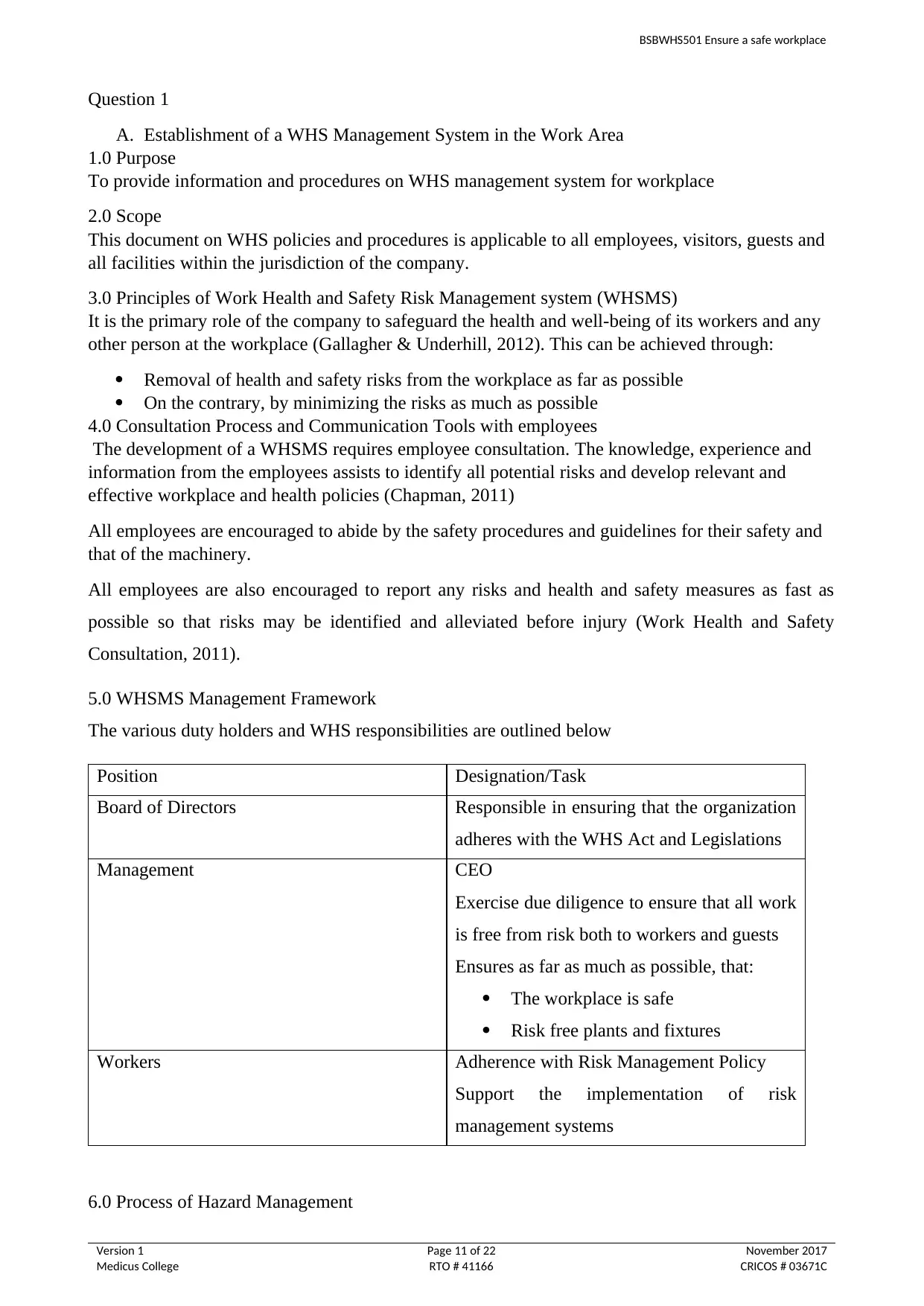
BSBWHS501 Ensure a safe workplace
Question 1
A. Establishment of a WHS Management System in the Work Area
1.0 Purpose
To provide information and procedures on WHS management system for workplace
2.0 Scope
This document on WHS policies and procedures is applicable to all employees, visitors, guests and
all facilities within the jurisdiction of the company.
3.0 Principles of Work Health and Safety Risk Management system (WHSMS)
It is the primary role of the company to safeguard the health and well-being of its workers and any
other person at the workplace (Gallagher & Underhill, 2012). This can be achieved through:
Removal of health and safety risks from the workplace as far as possible
On the contrary, by minimizing the risks as much as possible
4.0 Consultation Process and Communication Tools with employees
The development of a WHSMS requires employee consultation. The knowledge, experience and
information from the employees assists to identify all potential risks and develop relevant and
effective workplace and health policies (Chapman, 2011)
All employees are encouraged to abide by the safety procedures and guidelines for their safety and
that of the machinery.
All employees are also encouraged to report any risks and health and safety measures as fast as
possible so that risks may be identified and alleviated before injury (Work Health and Safety
Consultation, 2011).
5.0 WHSMS Management Framework
The various duty holders and WHS responsibilities are outlined below
Position Designation/Task
Board of Directors Responsible in ensuring that the organization
adheres with the WHS Act and Legislations
Management CEO
Exercise due diligence to ensure that all work
is free from risk both to workers and guests
Ensures as far as much as possible, that:
The workplace is safe
Risk free plants and fixtures
Workers Adherence with Risk Management Policy
Support the implementation of risk
management systems
6.0 Process of Hazard Management
Version 1 Page 11 of 22 November 2017
Medicus College RTO # 41166 CRICOS # 03671C
Question 1
A. Establishment of a WHS Management System in the Work Area
1.0 Purpose
To provide information and procedures on WHS management system for workplace
2.0 Scope
This document on WHS policies and procedures is applicable to all employees, visitors, guests and
all facilities within the jurisdiction of the company.
3.0 Principles of Work Health and Safety Risk Management system (WHSMS)
It is the primary role of the company to safeguard the health and well-being of its workers and any
other person at the workplace (Gallagher & Underhill, 2012). This can be achieved through:
Removal of health and safety risks from the workplace as far as possible
On the contrary, by minimizing the risks as much as possible
4.0 Consultation Process and Communication Tools with employees
The development of a WHSMS requires employee consultation. The knowledge, experience and
information from the employees assists to identify all potential risks and develop relevant and
effective workplace and health policies (Chapman, 2011)
All employees are encouraged to abide by the safety procedures and guidelines for their safety and
that of the machinery.
All employees are also encouraged to report any risks and health and safety measures as fast as
possible so that risks may be identified and alleviated before injury (Work Health and Safety
Consultation, 2011).
5.0 WHSMS Management Framework
The various duty holders and WHS responsibilities are outlined below
Position Designation/Task
Board of Directors Responsible in ensuring that the organization
adheres with the WHS Act and Legislations
Management CEO
Exercise due diligence to ensure that all work
is free from risk both to workers and guests
Ensures as far as much as possible, that:
The workplace is safe
Risk free plants and fixtures
Workers Adherence with Risk Management Policy
Support the implementation of risk
management systems
6.0 Process of Hazard Management
Version 1 Page 11 of 22 November 2017
Medicus College RTO # 41166 CRICOS # 03671C
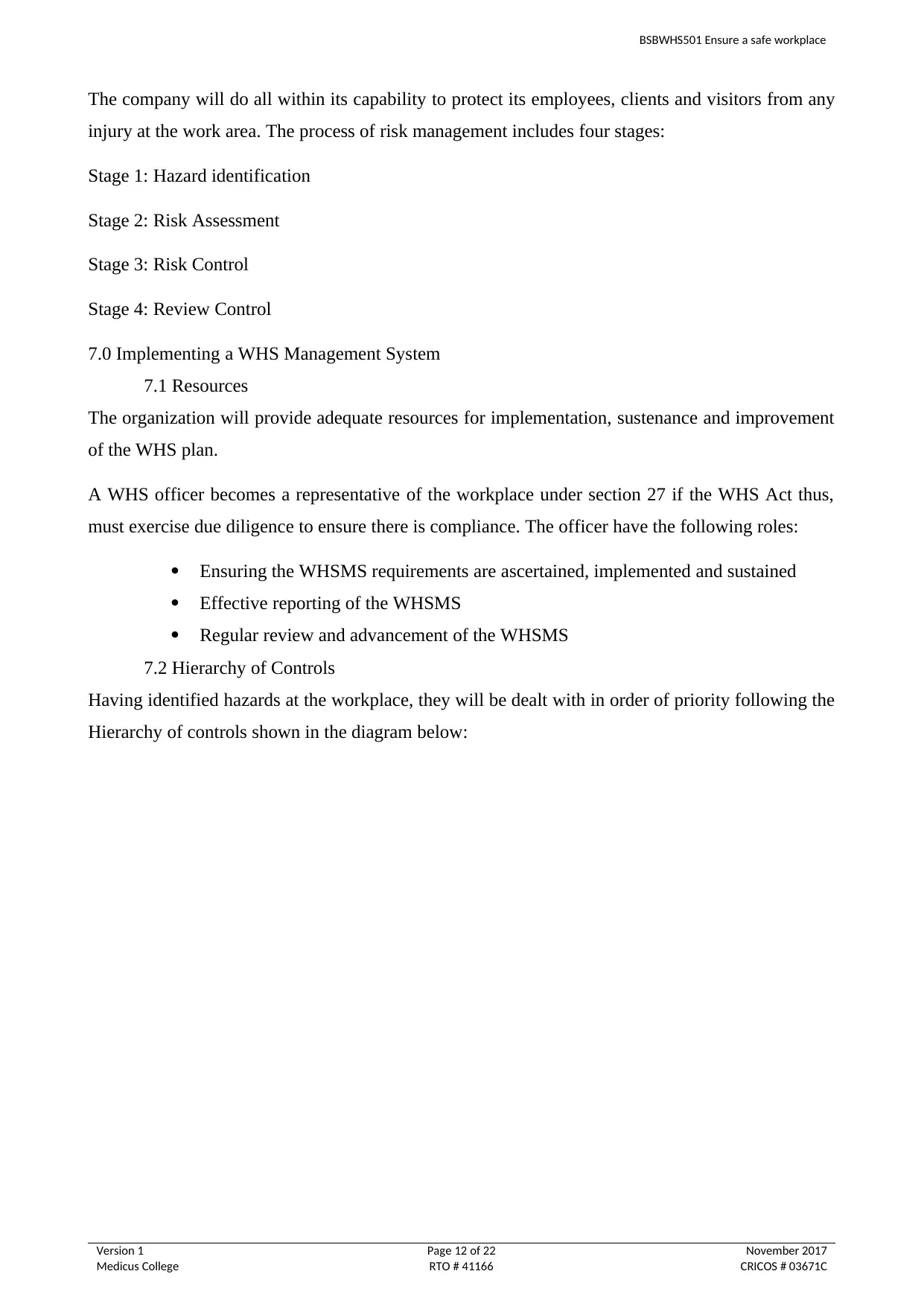
BSBWHS501 Ensure a safe workplace
The company will do all within its capability to protect its employees, clients and visitors from any
injury at the work area. The process of risk management includes four stages:
Stage 1: Hazard identification
Stage 2: Risk Assessment
Stage 3: Risk Control
Stage 4: Review Control
7.0 Implementing a WHS Management System
7.1 Resources
The organization will provide adequate resources for implementation, sustenance and improvement
of the WHS plan.
A WHS officer becomes a representative of the workplace under section 27 if the WHS Act thus,
must exercise due diligence to ensure there is compliance. The officer have the following roles:
Ensuring the WHSMS requirements are ascertained, implemented and sustained
Effective reporting of the WHSMS
Regular review and advancement of the WHSMS
7.2 Hierarchy of Controls
Having identified hazards at the workplace, they will be dealt with in order of priority following the
Hierarchy of controls shown in the diagram below:
Version 1 Page 12 of 22 November 2017
Medicus College RTO # 41166 CRICOS # 03671C
The company will do all within its capability to protect its employees, clients and visitors from any
injury at the work area. The process of risk management includes four stages:
Stage 1: Hazard identification
Stage 2: Risk Assessment
Stage 3: Risk Control
Stage 4: Review Control
7.0 Implementing a WHS Management System
7.1 Resources
The organization will provide adequate resources for implementation, sustenance and improvement
of the WHS plan.
A WHS officer becomes a representative of the workplace under section 27 if the WHS Act thus,
must exercise due diligence to ensure there is compliance. The officer have the following roles:
Ensuring the WHSMS requirements are ascertained, implemented and sustained
Effective reporting of the WHSMS
Regular review and advancement of the WHSMS
7.2 Hierarchy of Controls
Having identified hazards at the workplace, they will be dealt with in order of priority following the
Hierarchy of controls shown in the diagram below:
Version 1 Page 12 of 22 November 2017
Medicus College RTO # 41166 CRICOS # 03671C
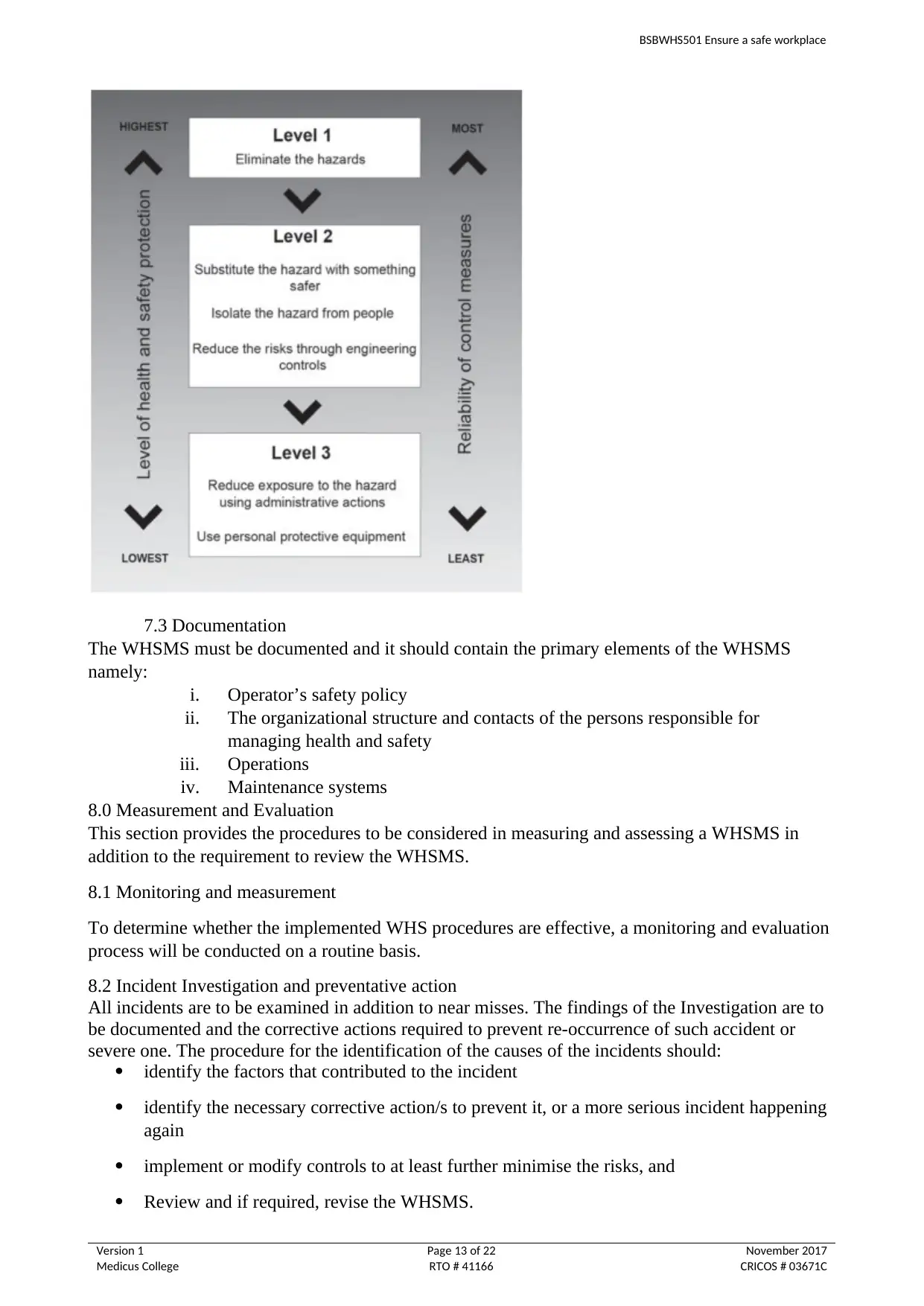
BSBWHS501 Ensure a safe workplace
7.3 Documentation
The WHSMS must be documented and it should contain the primary elements of the WHSMS
namely:
i. Operator’s safety policy
ii. The organizational structure and contacts of the persons responsible for
managing health and safety
iii. Operations
iv. Maintenance systems
8.0 Measurement and Evaluation
This section provides the procedures to be considered in measuring and assessing a WHSMS in
addition to the requirement to review the WHSMS.
8.1 Monitoring and measurement
To determine whether the implemented WHS procedures are effective, a monitoring and evaluation
process will be conducted on a routine basis.
8.2 Incident Investigation and preventative action
All incidents are to be examined in addition to near misses. The findings of the Investigation are to
be documented and the corrective actions required to prevent re-occurrence of such accident or
severe one. The procedure for the identification of the causes of the incidents should:
identify the factors that contributed to the incident
identify the necessary corrective action/s to prevent it, or a more serious incident happening
again
implement or modify controls to at least further minimise the risks, and
Review and if required, revise the WHSMS.
Version 1 Page 13 of 22 November 2017
Medicus College RTO # 41166 CRICOS # 03671C
7.3 Documentation
The WHSMS must be documented and it should contain the primary elements of the WHSMS
namely:
i. Operator’s safety policy
ii. The organizational structure and contacts of the persons responsible for
managing health and safety
iii. Operations
iv. Maintenance systems
8.0 Measurement and Evaluation
This section provides the procedures to be considered in measuring and assessing a WHSMS in
addition to the requirement to review the WHSMS.
8.1 Monitoring and measurement
To determine whether the implemented WHS procedures are effective, a monitoring and evaluation
process will be conducted on a routine basis.
8.2 Incident Investigation and preventative action
All incidents are to be examined in addition to near misses. The findings of the Investigation are to
be documented and the corrective actions required to prevent re-occurrence of such accident or
severe one. The procedure for the identification of the causes of the incidents should:
identify the factors that contributed to the incident
identify the necessary corrective action/s to prevent it, or a more serious incident happening
again
implement or modify controls to at least further minimise the risks, and
Review and if required, revise the WHSMS.
Version 1 Page 13 of 22 November 2017
Medicus College RTO # 41166 CRICOS # 03671C
Paraphrase This Document
Need a fresh take? Get an instant paraphrase of this document with our AI Paraphraser
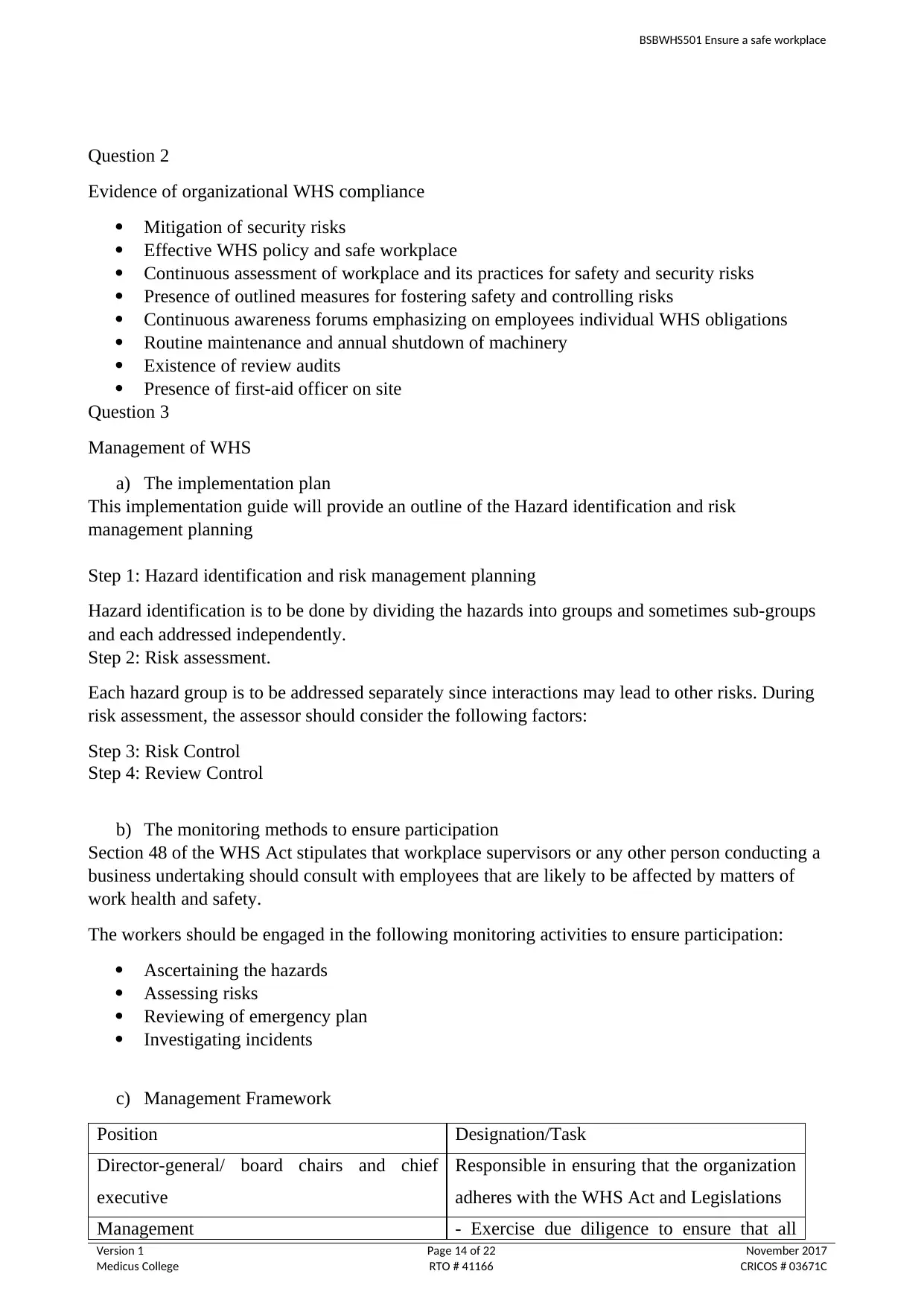
BSBWHS501 Ensure a safe workplace
Question 2
Evidence of organizational WHS compliance
Mitigation of security risks
Effective WHS policy and safe workplace
Continuous assessment of workplace and its practices for safety and security risks
Presence of outlined measures for fostering safety and controlling risks
Continuous awareness forums emphasizing on employees individual WHS obligations
Routine maintenance and annual shutdown of machinery
Existence of review audits
Presence of first-aid officer on site
Question 3
Management of WHS
a) The implementation plan
This implementation guide will provide an outline of the Hazard identification and risk
management planning
Step 1: Hazard identification and risk management planning
Hazard identification is to be done by dividing the hazards into groups and sometimes sub-groups
and each addressed independently.
Step 2: Risk assessment.
Each hazard group is to be addressed separately since interactions may lead to other risks. During
risk assessment, the assessor should consider the following factors:
Step 3: Risk Control
Step 4: Review Control
b) The monitoring methods to ensure participation
Section 48 of the WHS Act stipulates that workplace supervisors or any other person conducting a
business undertaking should consult with employees that are likely to be affected by matters of
work health and safety.
The workers should be engaged in the following monitoring activities to ensure participation:
Ascertaining the hazards
Assessing risks
Reviewing of emergency plan
Investigating incidents
c) Management Framework
Position Designation/Task
Director-general/ board chairs and chief
executive
Responsible in ensuring that the organization
adheres with the WHS Act and Legislations
Management - Exercise due diligence to ensure that all
Version 1 Page 14 of 22 November 2017
Medicus College RTO # 41166 CRICOS # 03671C
Question 2
Evidence of organizational WHS compliance
Mitigation of security risks
Effective WHS policy and safe workplace
Continuous assessment of workplace and its practices for safety and security risks
Presence of outlined measures for fostering safety and controlling risks
Continuous awareness forums emphasizing on employees individual WHS obligations
Routine maintenance and annual shutdown of machinery
Existence of review audits
Presence of first-aid officer on site
Question 3
Management of WHS
a) The implementation plan
This implementation guide will provide an outline of the Hazard identification and risk
management planning
Step 1: Hazard identification and risk management planning
Hazard identification is to be done by dividing the hazards into groups and sometimes sub-groups
and each addressed independently.
Step 2: Risk assessment.
Each hazard group is to be addressed separately since interactions may lead to other risks. During
risk assessment, the assessor should consider the following factors:
Step 3: Risk Control
Step 4: Review Control
b) The monitoring methods to ensure participation
Section 48 of the WHS Act stipulates that workplace supervisors or any other person conducting a
business undertaking should consult with employees that are likely to be affected by matters of
work health and safety.
The workers should be engaged in the following monitoring activities to ensure participation:
Ascertaining the hazards
Assessing risks
Reviewing of emergency plan
Investigating incidents
c) Management Framework
Position Designation/Task
Director-general/ board chairs and chief
executive
Responsible in ensuring that the organization
adheres with the WHS Act and Legislations
Management - Exercise due diligence to ensure that all
Version 1 Page 14 of 22 November 2017
Medicus College RTO # 41166 CRICOS # 03671C
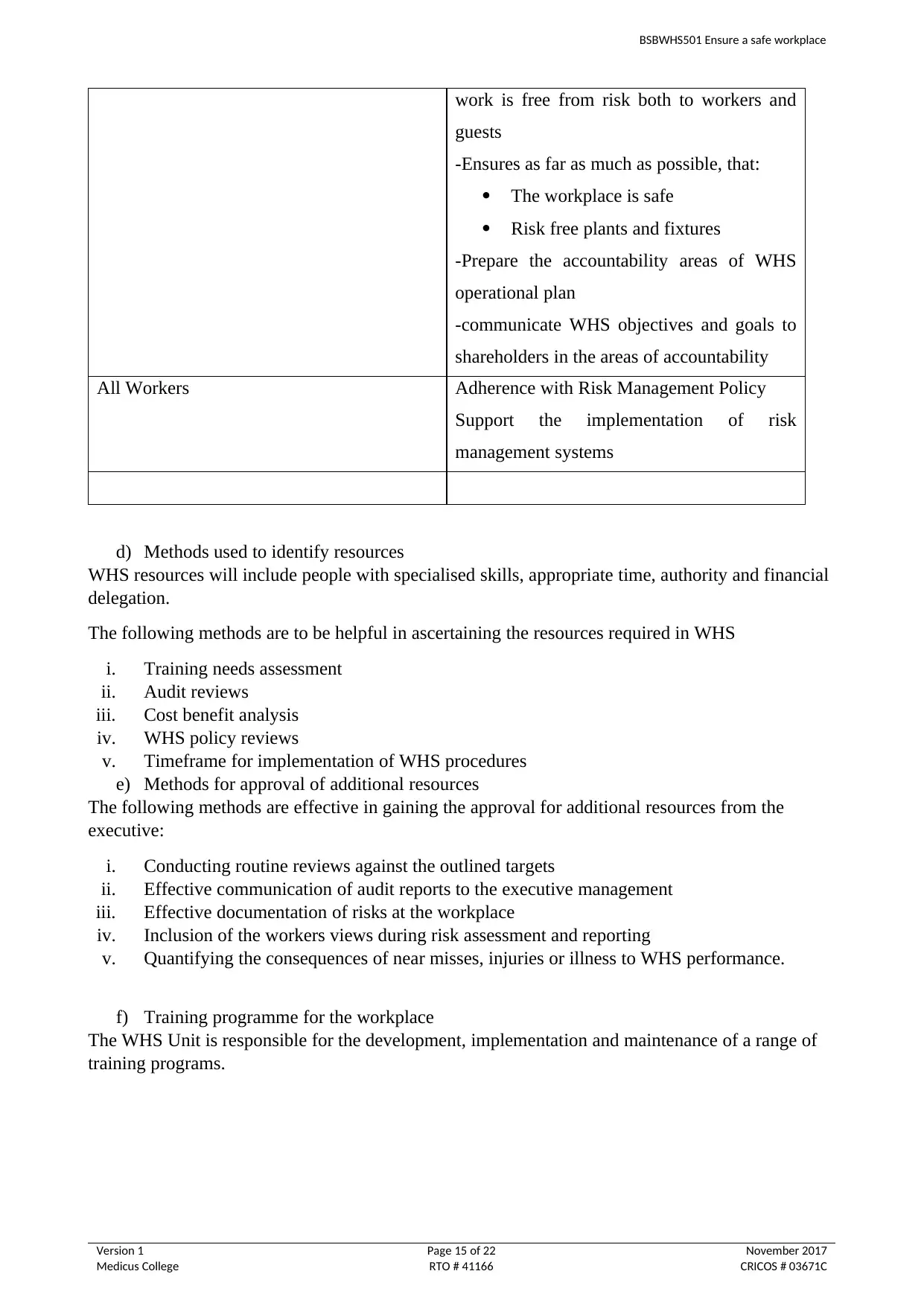
BSBWHS501 Ensure a safe workplace
work is free from risk both to workers and
guests
-Ensures as far as much as possible, that:
The workplace is safe
Risk free plants and fixtures
-Prepare the accountability areas of WHS
operational plan
-communicate WHS objectives and goals to
shareholders in the areas of accountability
All Workers Adherence with Risk Management Policy
Support the implementation of risk
management systems
d) Methods used to identify resources
WHS resources will include people with specialised skills, appropriate time, authority and financial
delegation.
The following methods are to be helpful in ascertaining the resources required in WHS
i. Training needs assessment
ii. Audit reviews
iii. Cost benefit analysis
iv. WHS policy reviews
v. Timeframe for implementation of WHS procedures
e) Methods for approval of additional resources
The following methods are effective in gaining the approval for additional resources from the
executive:
i. Conducting routine reviews against the outlined targets
ii. Effective communication of audit reports to the executive management
iii. Effective documentation of risks at the workplace
iv. Inclusion of the workers views during risk assessment and reporting
v. Quantifying the consequences of near misses, injuries or illness to WHS performance.
f) Training programme for the workplace
The WHS Unit is responsible for the development, implementation and maintenance of a range of
training programs.
Version 1 Page 15 of 22 November 2017
Medicus College RTO # 41166 CRICOS # 03671C
work is free from risk both to workers and
guests
-Ensures as far as much as possible, that:
The workplace is safe
Risk free plants and fixtures
-Prepare the accountability areas of WHS
operational plan
-communicate WHS objectives and goals to
shareholders in the areas of accountability
All Workers Adherence with Risk Management Policy
Support the implementation of risk
management systems
d) Methods used to identify resources
WHS resources will include people with specialised skills, appropriate time, authority and financial
delegation.
The following methods are to be helpful in ascertaining the resources required in WHS
i. Training needs assessment
ii. Audit reviews
iii. Cost benefit analysis
iv. WHS policy reviews
v. Timeframe for implementation of WHS procedures
e) Methods for approval of additional resources
The following methods are effective in gaining the approval for additional resources from the
executive:
i. Conducting routine reviews against the outlined targets
ii. Effective communication of audit reports to the executive management
iii. Effective documentation of risks at the workplace
iv. Inclusion of the workers views during risk assessment and reporting
v. Quantifying the consequences of near misses, injuries or illness to WHS performance.
f) Training programme for the workplace
The WHS Unit is responsible for the development, implementation and maintenance of a range of
training programs.
Version 1 Page 15 of 22 November 2017
Medicus College RTO # 41166 CRICOS # 03671C
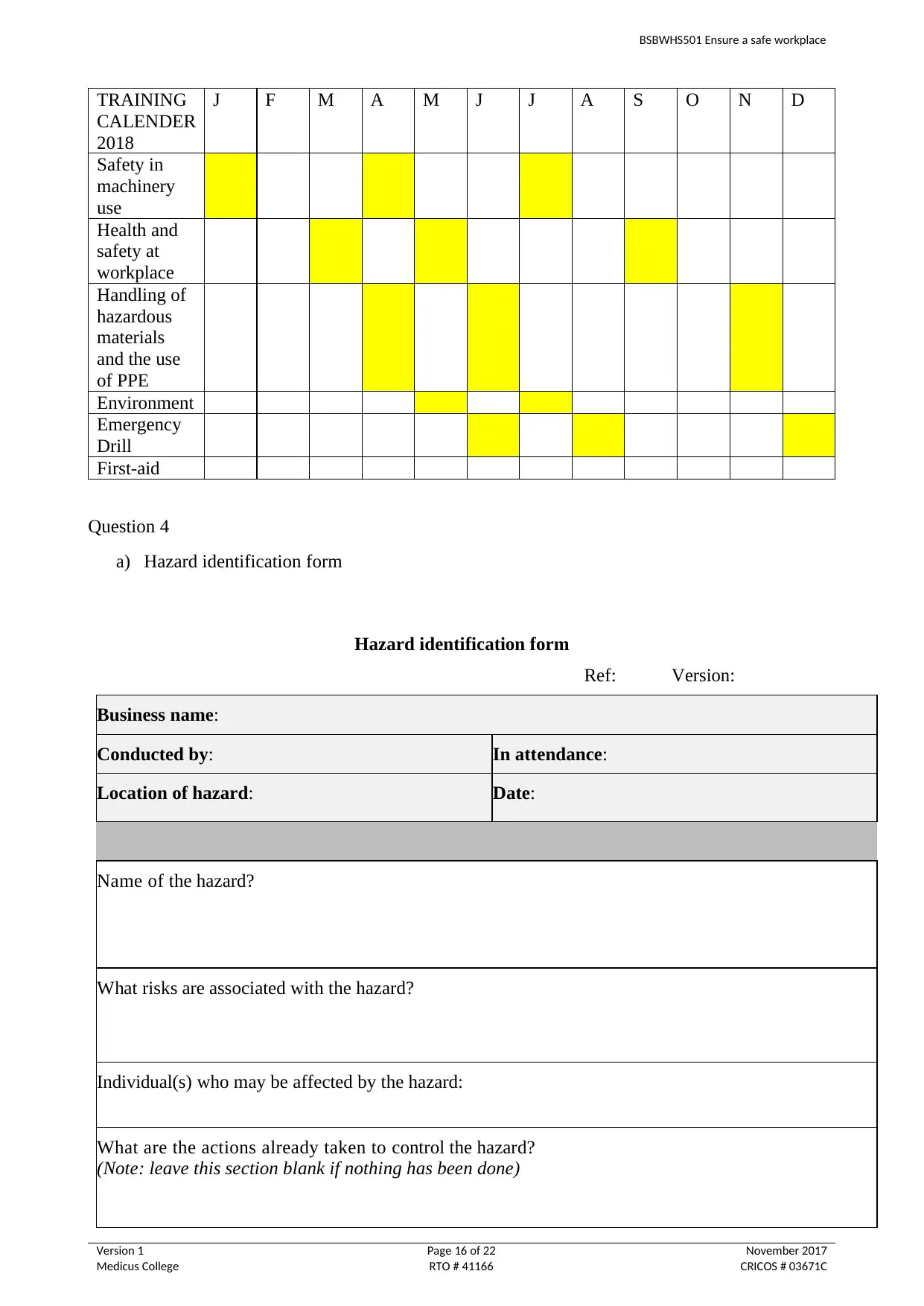
BSBWHS501 Ensure a safe workplace
TRAINING
CALENDER
2018
J F M A M J J A S O N D
Safety in
machinery
use
Health and
safety at
workplace
Handling of
hazardous
materials
and the use
of PPE
Environment
Emergency
Drill
First-aid
Question 4
a) Hazard identification form
Hazard identification form
Ref: Version:
Business name:
Conducted by: In attendance:
Location of hazard: Date:
Name of the hazard?
What risks are associated with the hazard?
Individual(s) who may be affected by the hazard:
What are the actions already taken to control the hazard?
(Note: leave this section blank if nothing has been done)
Version 1 Page 16 of 22 November 2017
Medicus College RTO # 41166 CRICOS # 03671C
TRAINING
CALENDER
2018
J F M A M J J A S O N D
Safety in
machinery
use
Health and
safety at
workplace
Handling of
hazardous
materials
and the use
of PPE
Environment
Emergency
Drill
First-aid
Question 4
a) Hazard identification form
Hazard identification form
Ref: Version:
Business name:
Conducted by: In attendance:
Location of hazard: Date:
Name of the hazard?
What risks are associated with the hazard?
Individual(s) who may be affected by the hazard:
What are the actions already taken to control the hazard?
(Note: leave this section blank if nothing has been done)
Version 1 Page 16 of 22 November 2017
Medicus College RTO # 41166 CRICOS # 03671C
Secure Best Marks with AI Grader
Need help grading? Try our AI Grader for instant feedback on your assignments.
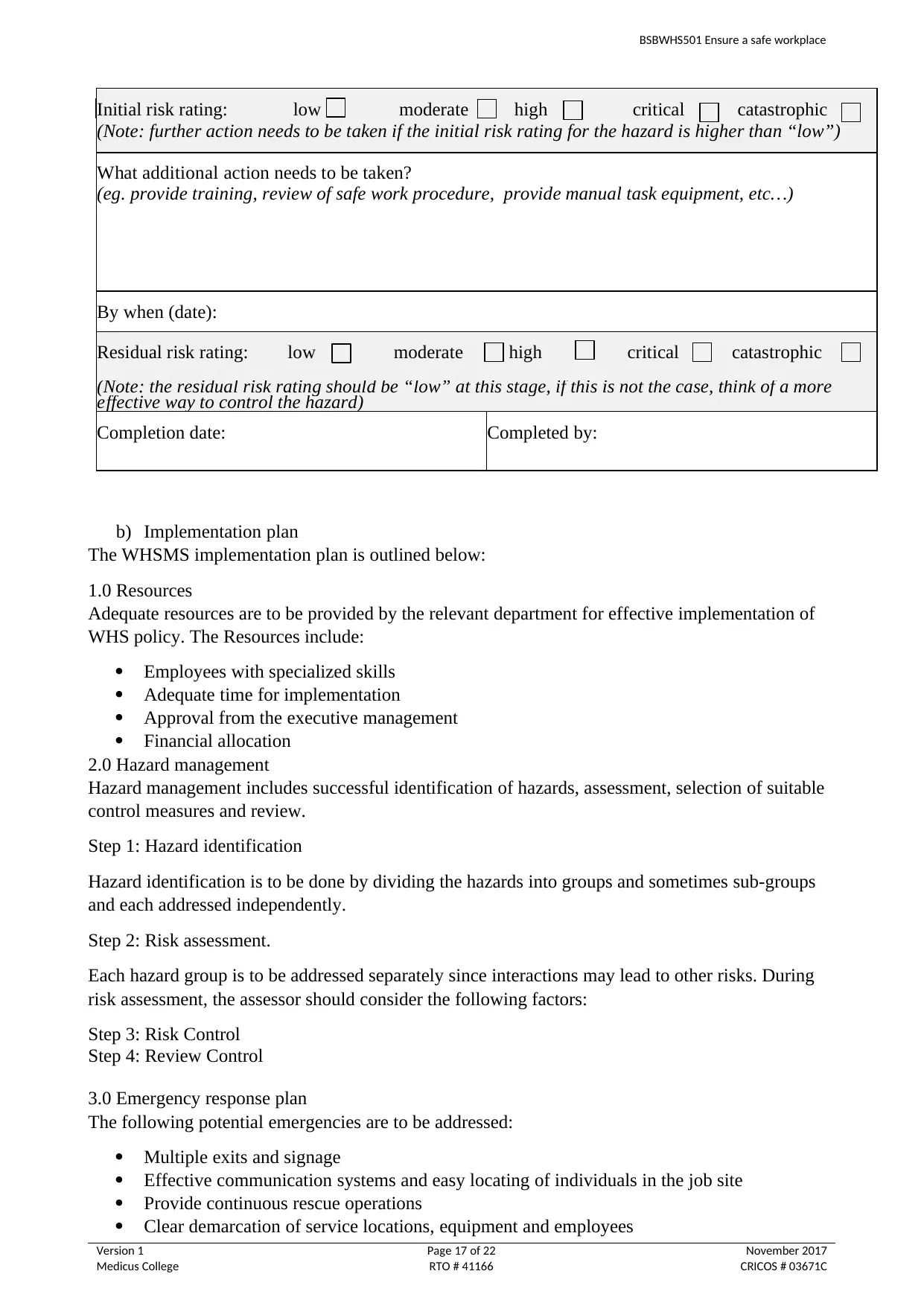
BSBWHS501 Ensure a safe workplace
Initial risk rating: low moderate high critical catastrophic
(Note: further action needs to be taken if the initial risk rating for the hazard is higher than “low”)
What additional action needs to be taken?
(eg. provide training, review of safe work procedure, provide manual task equipment, etc…)
By when (date):
Residual risk rating: low moderate high critical catastrophic
(Note: the residual risk rating should be “low” at this stage, if this is not the case, think of a more
effective way to control the hazard)
Completion date: Completed by:
b) Implementation plan
The WHSMS implementation plan is outlined below:
1.0 Resources
Adequate resources are to be provided by the relevant department for effective implementation of
WHS policy. The Resources include:
Employees with specialized skills
Adequate time for implementation
Approval from the executive management
Financial allocation
2.0 Hazard management
Hazard management includes successful identification of hazards, assessment, selection of suitable
control measures and review.
Step 1: Hazard identification
Hazard identification is to be done by dividing the hazards into groups and sometimes sub-groups
and each addressed independently.
Step 2: Risk assessment.
Each hazard group is to be addressed separately since interactions may lead to other risks. During
risk assessment, the assessor should consider the following factors:
Step 3: Risk Control
Step 4: Review Control
3.0 Emergency response plan
The following potential emergencies are to be addressed:
Multiple exits and signage
Effective communication systems and easy locating of individuals in the job site
Provide continuous rescue operations
Clear demarcation of service locations, equipment and employees
Version 1 Page 17 of 22 November 2017
Medicus College RTO # 41166 CRICOS # 03671C
Initial risk rating: low moderate high critical catastrophic
(Note: further action needs to be taken if the initial risk rating for the hazard is higher than “low”)
What additional action needs to be taken?
(eg. provide training, review of safe work procedure, provide manual task equipment, etc…)
By when (date):
Residual risk rating: low moderate high critical catastrophic
(Note: the residual risk rating should be “low” at this stage, if this is not the case, think of a more
effective way to control the hazard)
Completion date: Completed by:
b) Implementation plan
The WHSMS implementation plan is outlined below:
1.0 Resources
Adequate resources are to be provided by the relevant department for effective implementation of
WHS policy. The Resources include:
Employees with specialized skills
Adequate time for implementation
Approval from the executive management
Financial allocation
2.0 Hazard management
Hazard management includes successful identification of hazards, assessment, selection of suitable
control measures and review.
Step 1: Hazard identification
Hazard identification is to be done by dividing the hazards into groups and sometimes sub-groups
and each addressed independently.
Step 2: Risk assessment.
Each hazard group is to be addressed separately since interactions may lead to other risks. During
risk assessment, the assessor should consider the following factors:
Step 3: Risk Control
Step 4: Review Control
3.0 Emergency response plan
The following potential emergencies are to be addressed:
Multiple exits and signage
Effective communication systems and easy locating of individuals in the job site
Provide continuous rescue operations
Clear demarcation of service locations, equipment and employees
Version 1 Page 17 of 22 November 2017
Medicus College RTO # 41166 CRICOS # 03671C
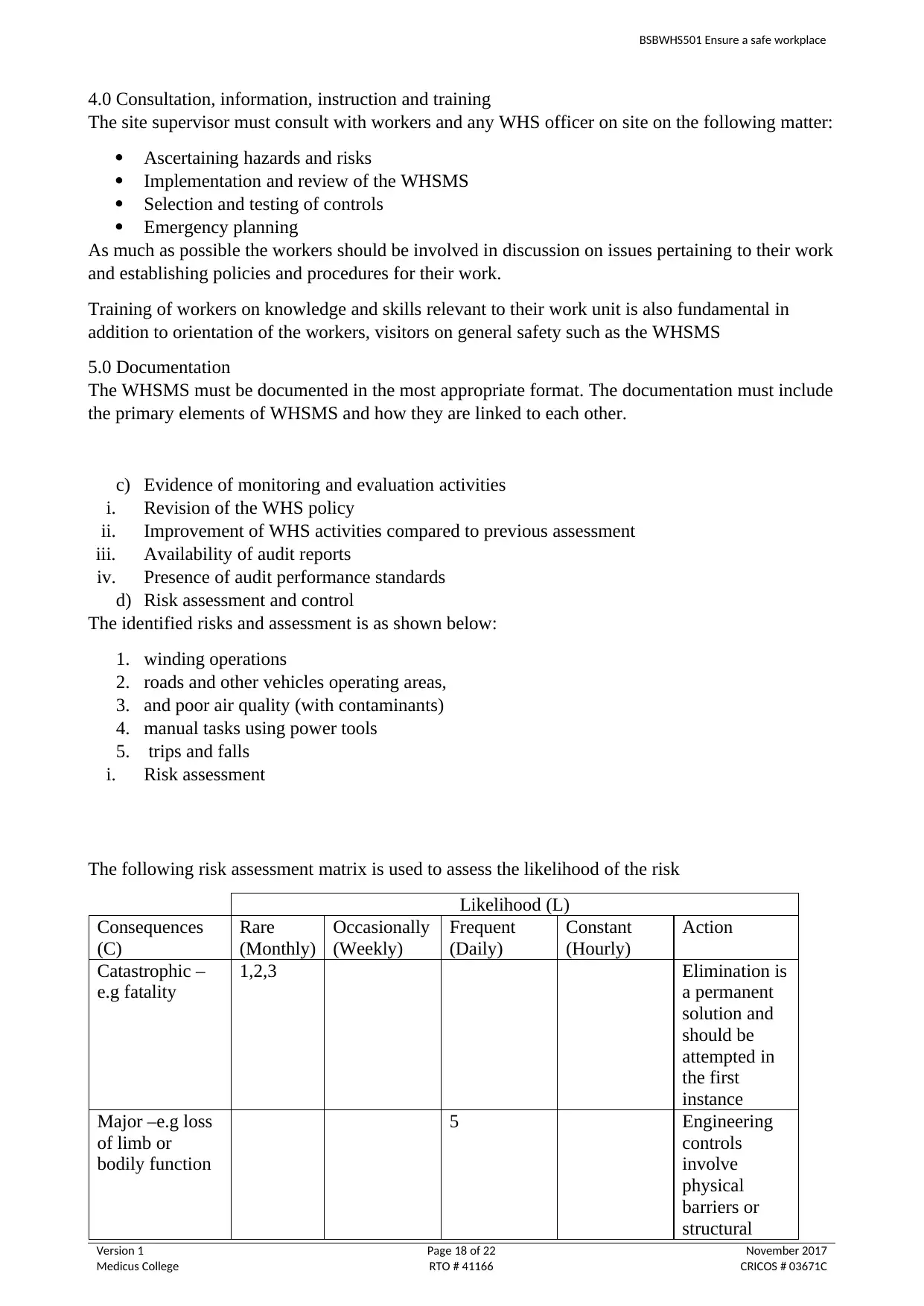
BSBWHS501 Ensure a safe workplace
4.0 Consultation, information, instruction and training
The site supervisor must consult with workers and any WHS officer on site on the following matter:
Ascertaining hazards and risks
Implementation and review of the WHSMS
Selection and testing of controls
Emergency planning
As much as possible the workers should be involved in discussion on issues pertaining to their work
and establishing policies and procedures for their work.
Training of workers on knowledge and skills relevant to their work unit is also fundamental in
addition to orientation of the workers, visitors on general safety such as the WHSMS
5.0 Documentation
The WHSMS must be documented in the most appropriate format. The documentation must include
the primary elements of WHSMS and how they are linked to each other.
c) Evidence of monitoring and evaluation activities
i. Revision of the WHS policy
ii. Improvement of WHS activities compared to previous assessment
iii. Availability of audit reports
iv. Presence of audit performance standards
d) Risk assessment and control
The identified risks and assessment is as shown below:
1. winding operations
2. roads and other vehicles operating areas,
3. and poor air quality (with contaminants)
4. manual tasks using power tools
5. trips and falls
i. Risk assessment
The following risk assessment matrix is used to assess the likelihood of the risk
Likelihood (L)
Consequences
(C)
Rare
(Monthly)
Occasionally
(Weekly)
Frequent
(Daily)
Constant
(Hourly)
Action
Catastrophic –
e.g fatality
1,2,3 Elimination is
a permanent
solution and
should be
attempted in
the first
instance
Major –e.g loss
of limb or
bodily function
5 Engineering
controls
involve
physical
barriers or
structural
Version 1 Page 18 of 22 November 2017
Medicus College RTO # 41166 CRICOS # 03671C
4.0 Consultation, information, instruction and training
The site supervisor must consult with workers and any WHS officer on site on the following matter:
Ascertaining hazards and risks
Implementation and review of the WHSMS
Selection and testing of controls
Emergency planning
As much as possible the workers should be involved in discussion on issues pertaining to their work
and establishing policies and procedures for their work.
Training of workers on knowledge and skills relevant to their work unit is also fundamental in
addition to orientation of the workers, visitors on general safety such as the WHSMS
5.0 Documentation
The WHSMS must be documented in the most appropriate format. The documentation must include
the primary elements of WHSMS and how they are linked to each other.
c) Evidence of monitoring and evaluation activities
i. Revision of the WHS policy
ii. Improvement of WHS activities compared to previous assessment
iii. Availability of audit reports
iv. Presence of audit performance standards
d) Risk assessment and control
The identified risks and assessment is as shown below:
1. winding operations
2. roads and other vehicles operating areas,
3. and poor air quality (with contaminants)
4. manual tasks using power tools
5. trips and falls
i. Risk assessment
The following risk assessment matrix is used to assess the likelihood of the risk
Likelihood (L)
Consequences
(C)
Rare
(Monthly)
Occasionally
(Weekly)
Frequent
(Daily)
Constant
(Hourly)
Action
Catastrophic –
e.g fatality
1,2,3 Elimination is
a permanent
solution and
should be
attempted in
the first
instance
Major –e.g loss
of limb or
bodily function
5 Engineering
controls
involve
physical
barriers or
structural
Version 1 Page 18 of 22 November 2017
Medicus College RTO # 41166 CRICOS # 03671C
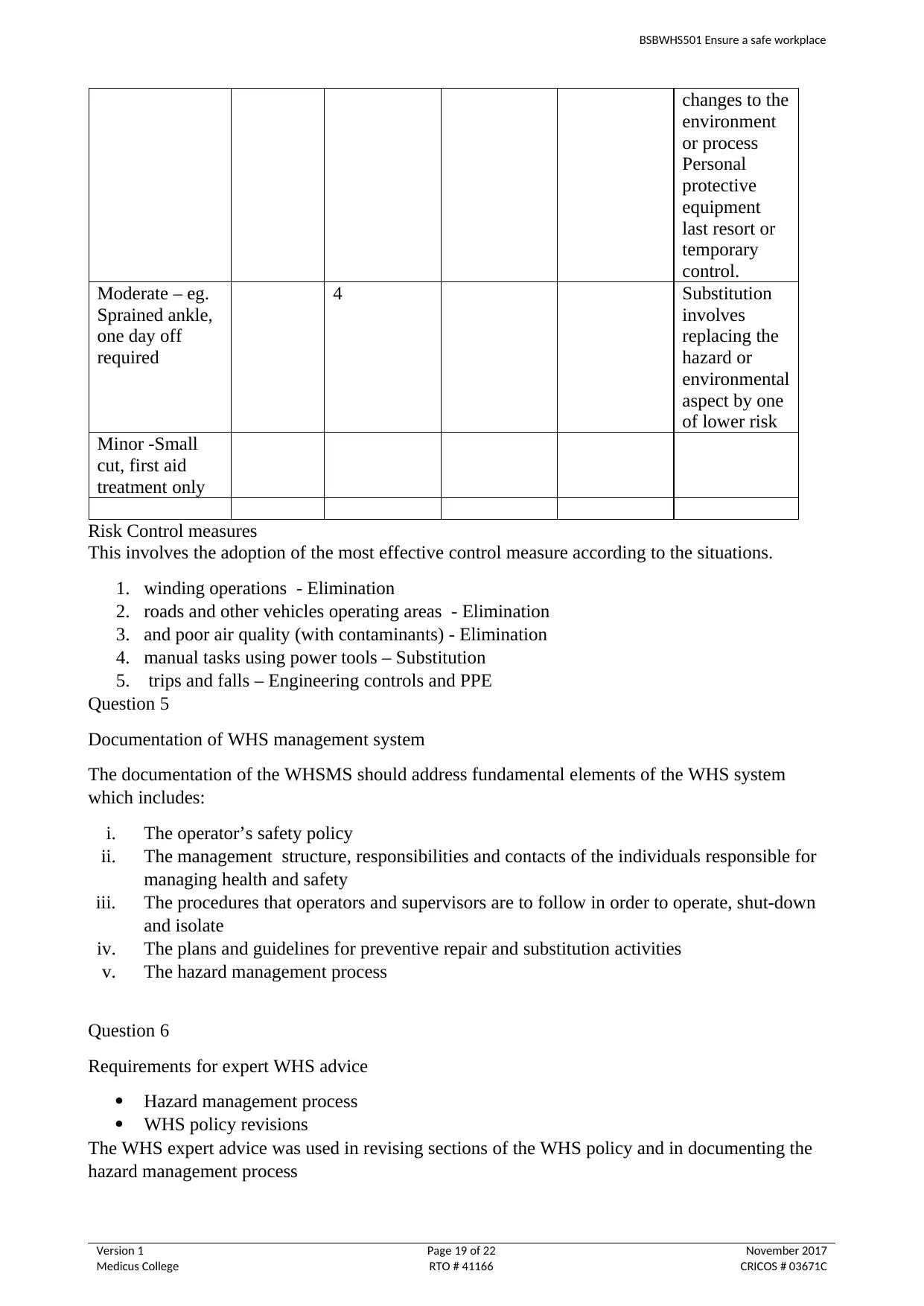
BSBWHS501 Ensure a safe workplace
changes to the
environment
or process
Personal
protective
equipment
last resort or
temporary
control.
Moderate – eg.
Sprained ankle,
one day off
required
4 Substitution
involves
replacing the
hazard or
environmental
aspect by one
of lower risk
Minor -Small
cut, first aid
treatment only
Risk Control measures
This involves the adoption of the most effective control measure according to the situations.
1. winding operations - Elimination
2. roads and other vehicles operating areas - Elimination
3. and poor air quality (with contaminants) - Elimination
4. manual tasks using power tools – Substitution
5. trips and falls – Engineering controls and PPE
Question 5
Documentation of WHS management system
The documentation of the WHSMS should address fundamental elements of the WHS system
which includes:
i. The operator’s safety policy
ii. The management structure, responsibilities and contacts of the individuals responsible for
managing health and safety
iii. The procedures that operators and supervisors are to follow in order to operate, shut-down
and isolate
iv. The plans and guidelines for preventive repair and substitution activities
v. The hazard management process
Question 6
Requirements for expert WHS advice
Hazard management process
WHS policy revisions
The WHS expert advice was used in revising sections of the WHS policy and in documenting the
hazard management process
Version 1 Page 19 of 22 November 2017
Medicus College RTO # 41166 CRICOS # 03671C
changes to the
environment
or process
Personal
protective
equipment
last resort or
temporary
control.
Moderate – eg.
Sprained ankle,
one day off
required
4 Substitution
involves
replacing the
hazard or
environmental
aspect by one
of lower risk
Minor -Small
cut, first aid
treatment only
Risk Control measures
This involves the adoption of the most effective control measure according to the situations.
1. winding operations - Elimination
2. roads and other vehicles operating areas - Elimination
3. and poor air quality (with contaminants) - Elimination
4. manual tasks using power tools – Substitution
5. trips and falls – Engineering controls and PPE
Question 5
Documentation of WHS management system
The documentation of the WHSMS should address fundamental elements of the WHS system
which includes:
i. The operator’s safety policy
ii. The management structure, responsibilities and contacts of the individuals responsible for
managing health and safety
iii. The procedures that operators and supervisors are to follow in order to operate, shut-down
and isolate
iv. The plans and guidelines for preventive repair and substitution activities
v. The hazard management process
Question 6
Requirements for expert WHS advice
Hazard management process
WHS policy revisions
The WHS expert advice was used in revising sections of the WHS policy and in documenting the
hazard management process
Version 1 Page 19 of 22 November 2017
Medicus College RTO # 41166 CRICOS # 03671C
Paraphrase This Document
Need a fresh take? Get an instant paraphrase of this document with our AI Paraphraser
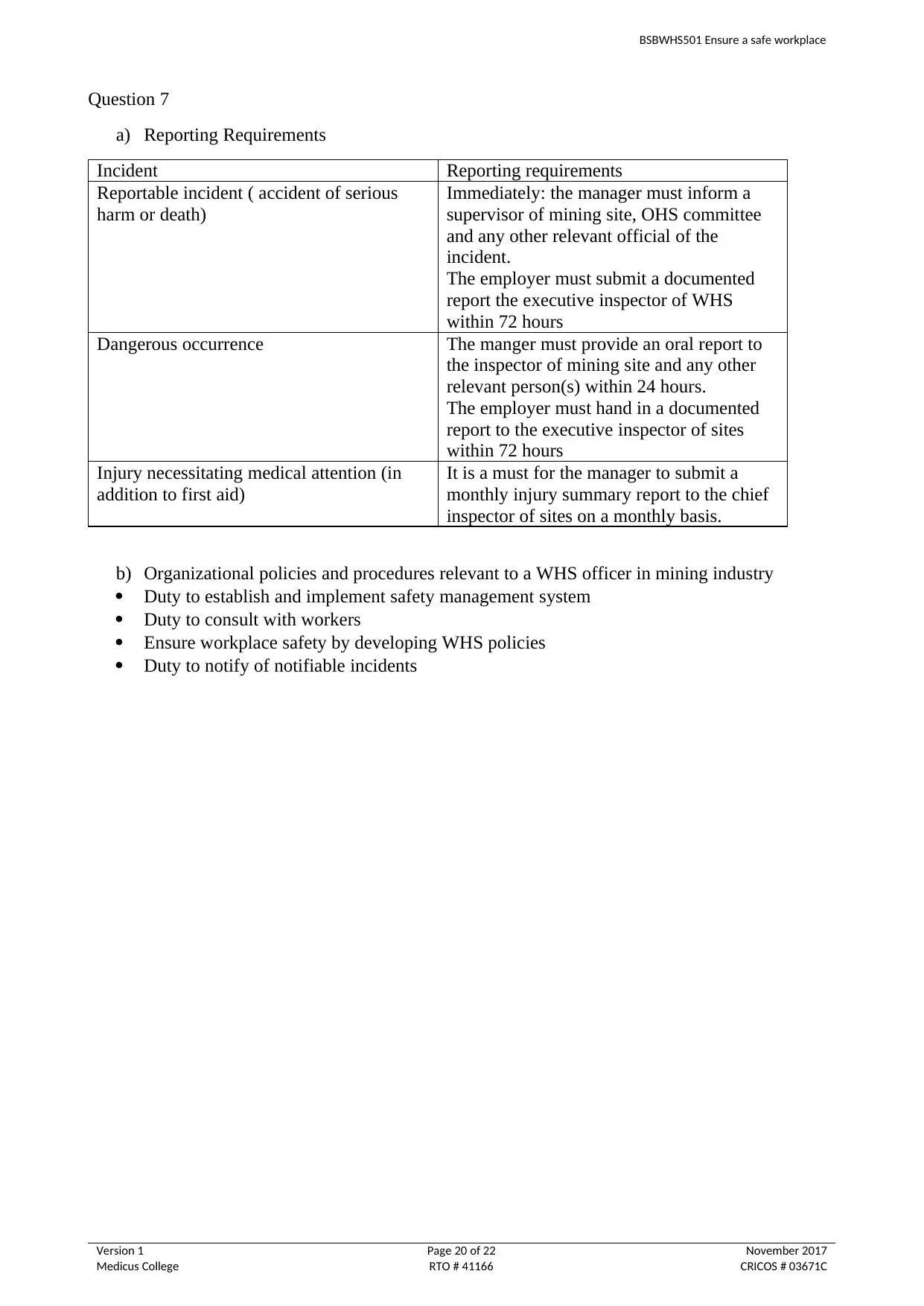
BSBWHS501 Ensure a safe workplace
Question 7
a) Reporting Requirements
Incident Reporting requirements
Reportable incident ( accident of serious
harm or death)
Immediately: the manager must inform a
supervisor of mining site, OHS committee
and any other relevant official of the
incident.
The employer must submit a documented
report the executive inspector of WHS
within 72 hours
Dangerous occurrence The manger must provide an oral report to
the inspector of mining site and any other
relevant person(s) within 24 hours.
The employer must hand in a documented
report to the executive inspector of sites
within 72 hours
Injury necessitating medical attention (in
addition to first aid)
It is a must for the manager to submit a
monthly injury summary report to the chief
inspector of sites on a monthly basis.
b) Organizational policies and procedures relevant to a WHS officer in mining industry
Duty to establish and implement safety management system
Duty to consult with workers
Ensure workplace safety by developing WHS policies
Duty to notify of notifiable incidents
Version 1 Page 20 of 22 November 2017
Medicus College RTO # 41166 CRICOS # 03671C
Question 7
a) Reporting Requirements
Incident Reporting requirements
Reportable incident ( accident of serious
harm or death)
Immediately: the manager must inform a
supervisor of mining site, OHS committee
and any other relevant official of the
incident.
The employer must submit a documented
report the executive inspector of WHS
within 72 hours
Dangerous occurrence The manger must provide an oral report to
the inspector of mining site and any other
relevant person(s) within 24 hours.
The employer must hand in a documented
report to the executive inspector of sites
within 72 hours
Injury necessitating medical attention (in
addition to first aid)
It is a must for the manager to submit a
monthly injury summary report to the chief
inspector of sites on a monthly basis.
b) Organizational policies and procedures relevant to a WHS officer in mining industry
Duty to establish and implement safety management system
Duty to consult with workers
Ensure workplace safety by developing WHS policies
Duty to notify of notifiable incidents
Version 1 Page 20 of 22 November 2017
Medicus College RTO # 41166 CRICOS # 03671C
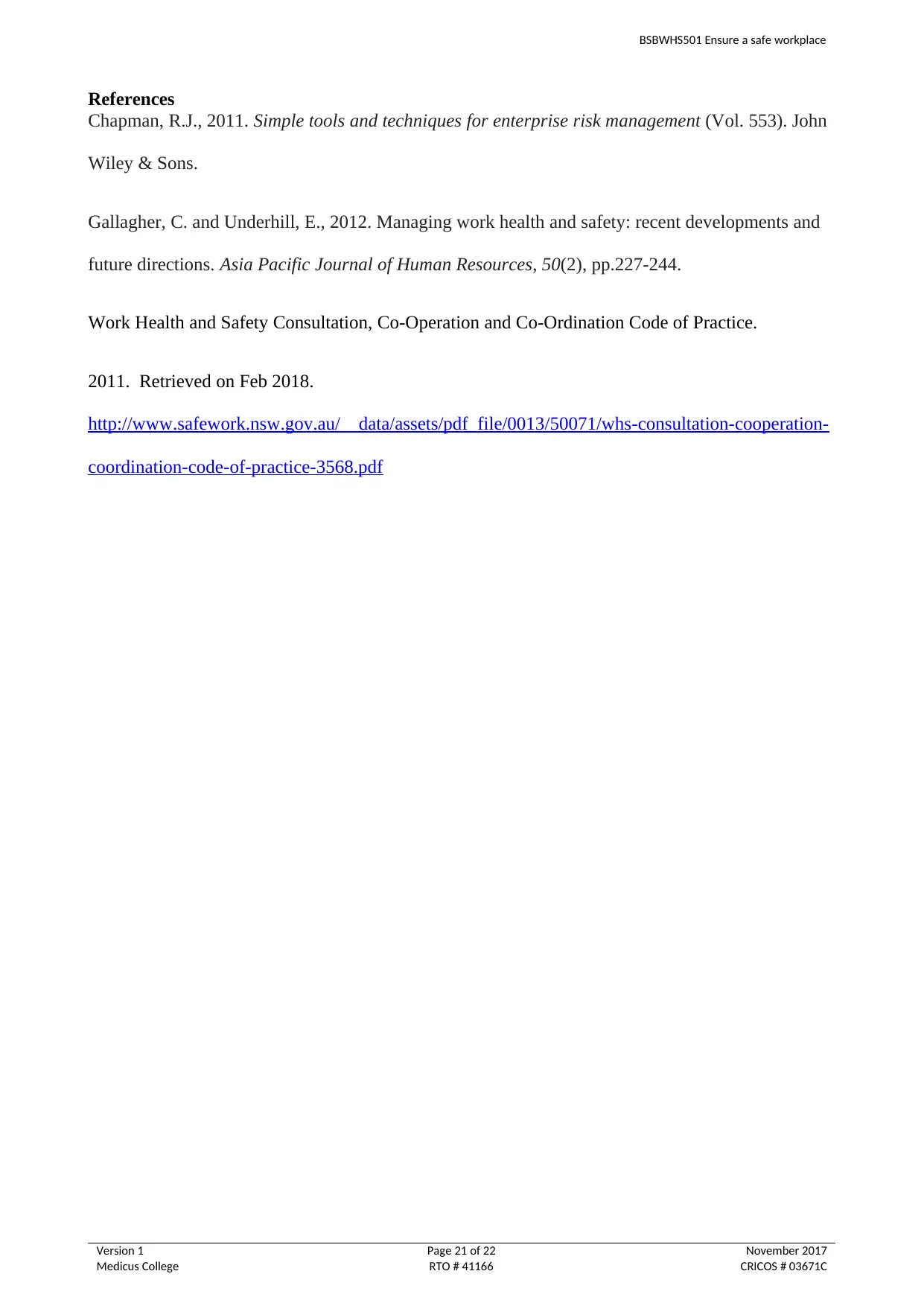
BSBWHS501 Ensure a safe workplace
References
Chapman, R.J., 2011. Simple tools and techniques for enterprise risk management (Vol. 553). John
Wiley & Sons.
Gallagher, C. and Underhill, E., 2012. Managing work health and safety: recent developments and
future directions. Asia Pacific Journal of Human Resources, 50(2), pp.227-244.
Work Health and Safety Consultation, Co-Operation and Co-Ordination Code of Practice.
2011. Retrieved on Feb 2018.
http://www.safework.nsw.gov.au/__data/assets/pdf_file/0013/50071/whs-consultation-cooperation-
coordination-code-of-practice-3568.pdf
Version 1 Page 21 of 22 November 2017
Medicus College RTO # 41166 CRICOS # 03671C
References
Chapman, R.J., 2011. Simple tools and techniques for enterprise risk management (Vol. 553). John
Wiley & Sons.
Gallagher, C. and Underhill, E., 2012. Managing work health and safety: recent developments and
future directions. Asia Pacific Journal of Human Resources, 50(2), pp.227-244.
Work Health and Safety Consultation, Co-Operation and Co-Ordination Code of Practice.
2011. Retrieved on Feb 2018.
http://www.safework.nsw.gov.au/__data/assets/pdf_file/0013/50071/whs-consultation-cooperation-
coordination-code-of-practice-3568.pdf
Version 1 Page 21 of 22 November 2017
Medicus College RTO # 41166 CRICOS # 03671C
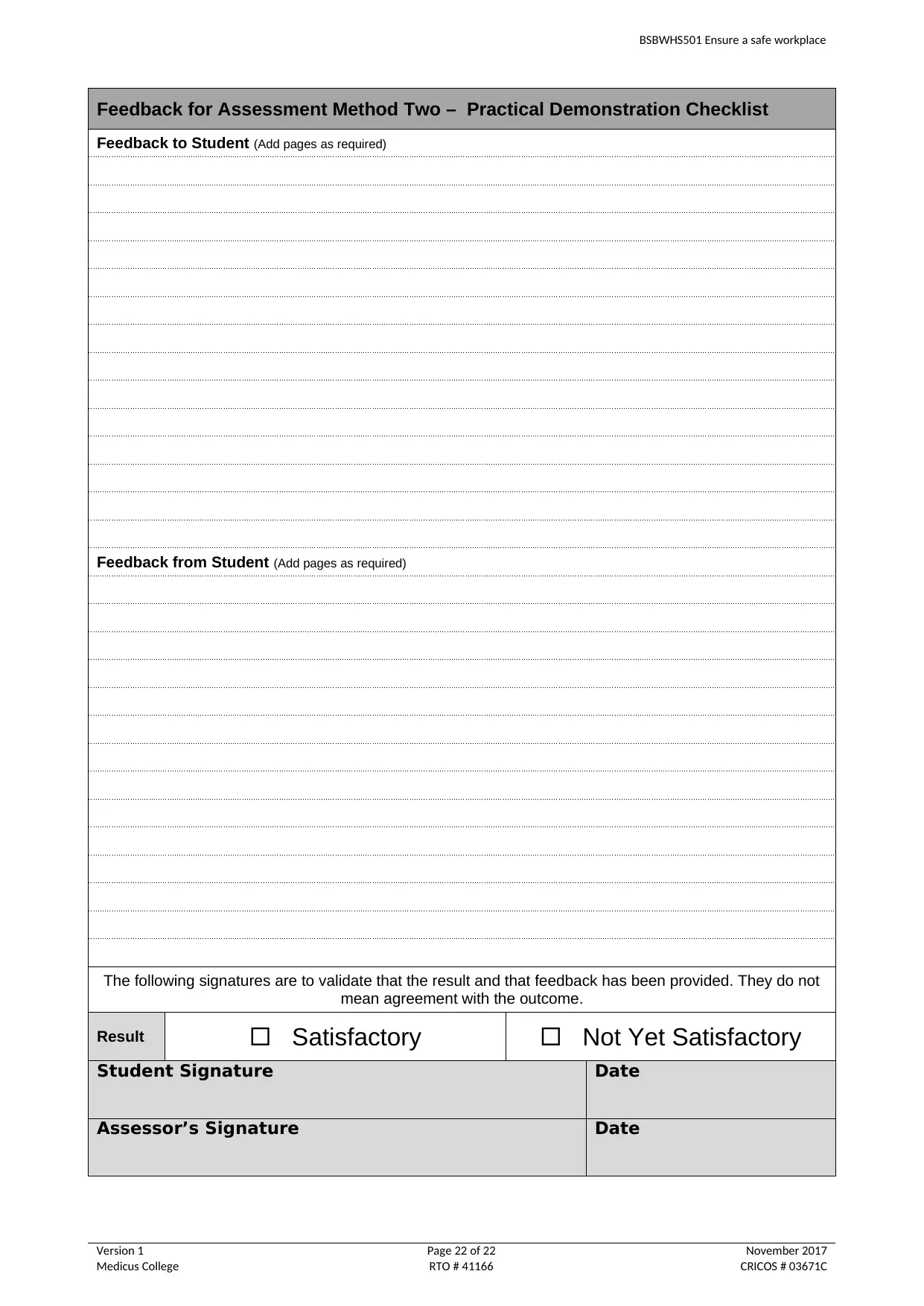
BSBWHS501 Ensure a safe workplace
Feedback for Assessment Method Two – Practical Demonstration Checklist
Feedback to Student (Add pages as required)
Feedback from Student (Add pages as required)
The following signatures are to validate that the result and that feedback has been provided. They do not
mean agreement with the outcome.
Result Satisfactory Not Yet Satisfactory
Student Signature Date
Assessor’s Signature Date
Version 1 Page 22 of 22 November 2017
Medicus College RTO # 41166 CRICOS # 03671C
Feedback for Assessment Method Two – Practical Demonstration Checklist
Feedback to Student (Add pages as required)
Feedback from Student (Add pages as required)
The following signatures are to validate that the result and that feedback has been provided. They do not
mean agreement with the outcome.
Result Satisfactory Not Yet Satisfactory
Student Signature Date
Assessor’s Signature Date
Version 1 Page 22 of 22 November 2017
Medicus College RTO # 41166 CRICOS # 03671C
1 out of 22
Related Documents
Your All-in-One AI-Powered Toolkit for Academic Success.
+13062052269
info@desklib.com
Available 24*7 on WhatsApp / Email
![[object Object]](/_next/static/media/star-bottom.7253800d.svg)
Unlock your academic potential
© 2024 | Zucol Services PVT LTD | All rights reserved.





